Sony Group PCGABA1 USB Bluetooth Dongle User Manual PCGA BA1 A
Sony Corporation USB Bluetooth Dongle PCGA BA1 A
Contents
- 1. Manual 1
- 2. Manual 2
- 3. Manual 3
Manual 1
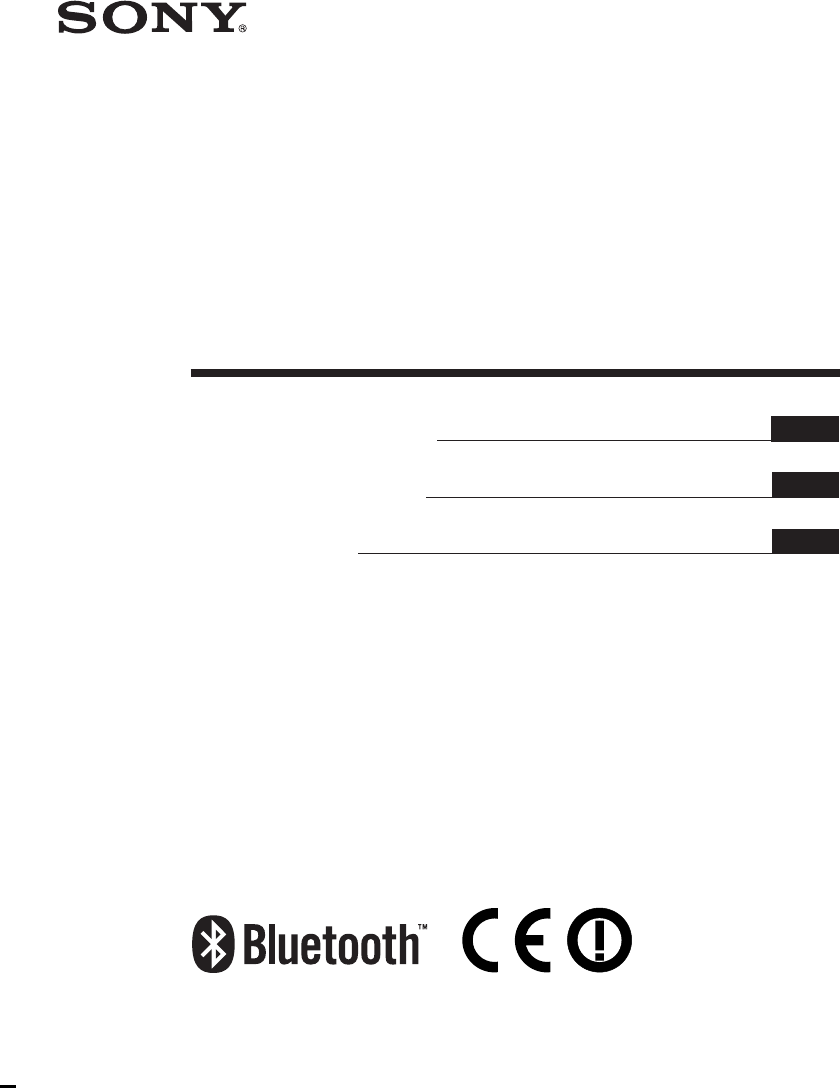
4-675-349-11(1)
2003 Sony Corporation
Bluetooth™
USB Adapter
PCGA-BA1 Series
DE
FR
GB
Operating Instructions
Bedienungsanleitung
Mode d’emploi
IT
2
GB
Warnings
❑To avoid electrical shock, do not
open the cabinet. Refer servicing to
qualified personnel only.
❑To prevent fire or shock hazard, do
not expose the unit to rain or
moisture.
❑In some situations or environments,
the use of the Bluetooth™
technology might be restricted by
the proprietor of the building or
responsible representatives of the
organization, for example on board
airplanes, in hospitals or in any
other environment where the risk of
interference with other devices or
services is perceived or identified as
harmful.
❑If you are uncertain about the policy
applying to the use of Bluetooth™
technology in a specific organization
or environment, you are encouraged
to first ask for authorization prior to
switching it on.
❑Consult your physician or the
manufacturer of personal medical
devices (pacemakers, hearing aids,
etc.) regarding any restrictions on
the use of Bluetooth™ technology.
Before using the PCGA-BA1, be sure
to read the accompanying End User
Software License Agreement.
❑Copyright laws prohibit reproducing
the software or the manual
accompanying it in whole or in part,
or renting the software without the
permission of the copyright holder.
❑In no event will Sony be liable for
any financial damages, or loss of
profits, including claims made by
third parties, arising out of the use of
the software supplied with this
device.
❑If a problem occurs with this
product as a result of defective
manufacturing, Sony will replace it.
However, Sony bears no other
responsibility.
❑The software provided with this unit
cannot be used with other units.
❑Please note that, due to continued
efforts to improve quality, the
software specifications may be
changed without notice.
❑Operation of this unit with software
other than that provided is not
covered by the warranty.

3
GB
Continued on next page
GB
Regulatory
information
For customers in Europe
Sony hereby declares that the
PCGA-BA1 Bluetooth™ USB
Adapter is in compliance with the
essential requirements and other
relevant provisions of European
Directive 1999/5/EC.
To obtain a copy of the declaration of
Conformity (DoC) with the R & TTE
Directive, please access the following
URL address:
http://www.compliance.Sony.de/
The PCGA-BA1 is a Bluetooth™
intended radio device using the 2.4
GHz frequency band (2.400GHz –
2.4835GHz).
It is intended for wireless
communication with other Bluetooth™
enabled devices using the Bluetooth™
Serial Port, Dial-up Networking via
mobile phone or modem, Object Push
and Basic Imaging profiles.
The PCGA-BA1 BluetoothTM
technology complies with regulations
in the following countries, and can
therefore only be used in these
countries:
Austria, Belgium, Denmark,
Finland, France, Germany, Greece,
Iceland, Ireland, Italy, Luxembourg,
Norway, Portugal, Spain, Sweden,
Switzerland, the Netherlands and
the United Kingdom.
In France, this product can only be
used indoors.
•VAIO and are registered
trademarks of Sony Corporation.
•Microsoft and Windows are
registered trademarks of Microsoft
Corporation in the United States
and/or other countries.
•
BLUETOOTH and its logo are
trademark owned by Bluetooth SIG,
Inc., U.S.A and licenced to Sony
Corporation.
•All other names of systems,
products and services are trademarks
of their respective owners. In the
manual, the ™ or ® marks are not
specified.
•In this manual, Microsoft®
Windows® XP Home Edition and
Microsoft® Windows® XP
Professional are referred to as
Windows XP.
4
GB
Voordat u de Bluetooth USB-adapter
gaat gebruiken, moet u de bijgaande
gebruiksrechtovereenkomst voor
eindgebruikers lezen.
❑De wet op de auteursrechten
verbiedt het geheel of gedeeltelijk
reproduceren van de software of de
handleiding, alsook de verhuur van
de software zonder toestemming van
de eigenaar van de auteursrechten.
❑Sony kan in geen geval aansprakelijk
worden gesteld voor financiële
verliezen noch winstderving, met
inbegrip van claims ingediend door
derden, ten gevolge van het gebruik
van de software die bij deze adapter
wordt geleverd.
❑Indien dit produkt problemen geeft
door constructiefouten, zal Sony het
vervangen. Sony draagt echter geen
enkele andere verantwoordelijkheid.
❑De software die bij dit toestel wordt
geleverd, kan niet met andere
toestellen worden gebruikt.
❑Merk op dat in het kader van ons
permanent streven naar
kwaliteitsverbetering de
softwarespecificaties steeds kunnen
worden gewijzigd zonder
voorafgaande kennisgeving.
❑Gebruik van dit toestel met andere
software dan de bijgeleverde is niet
gedekt door de waarborg.
Waarschuwing
❑Ter voorkoming van elektrische
schokken mag u de behuizing niet
openen. Laat service uitsluitend
uitvoeren door deskundig personeel.
❑Ter voorkoming van het gevaar van
brand of elektrische schokken, mag
u het produkt niet blootstellen aan
regen of vocht.
❑In bepaalde gevallen of omgevingen
kan het gebruik van de Bluetooth™
technologie beperkt worden door de
eigenaar van het gebouw of de
verantwoordelijke
vertegenwoordiger van de
organisatie. Bijvoorbeeld: aan boord
van een vliegtuig, in ziekenhuizen
of in andere omgevingen waar het
interferentierisico met andere
apparaten of diensten als schadelijk
wordt geëvalueerd of als zodanig
bepaald wordt.
❑Als u niet zeker bent over het
toegepaste beleid betreffende het
gebruik van de Bluetooth™
technologie in een specifieke
organisatie of omgeving, raden wij u
aan om eerst toelating te vragen
voor tot gebruik over te gaan.
❑Raadpleeg uw dokter of de fabrikant
van persoonlijke medische
apparaten (pacemakers,
hoorapparaten, enz.) betreffende
mogelijke beperkingen in het
gebruik van de Bluetooth™
technologie.

5
GB
Continued on next page
Wettelijke
informatie
Sony verklaart hierbij dat de PCGA-
BA1 Bluetooth™ USB Adapter
voldoet aan de essentiële vereisten en
andere relevante bepalingen van
richtlijn 1999/5/EC.
De PCGA-BA1 is een Bluetooth™
vermogensklasse 2 radiotoestel dat de
2,4 GHz (2,400 GHz - 2,4835 GHz)
frequentieband gebruikt. Het is
bestemd voor draadloze communicatie
met andere met Bluetooth™ uitgeruste
apparaten door gebruik te maken van
de profielen: Bluetooth™ seriële
poort, netwerk toegang via mobiele
telefoon of modem, Object Push en
Basic Imaging.
PCGA-BA1 voldoet aan alle
voorschriften die van toepassing zijn
in de volgende landen:
België, Denemarken, Duitsland,
Finland, Frankrijk, Griekenland,
Ierland, Ijsland, Italië, Luxemburg,
Nederland, Noorwegen, Oostenrijk,
Portugal, Spanje, Verenigd
Koninkrijk, Zweden en Zwitserland.
Dit produkt mag in Frankrijk alleen
maar binnenshuis gebruikt worden.
Dit produkt beantwoordt aan de
normen EN 55022 Class B en EN
55024 voor gebruik in de volgende
omgevingen: residentieel,
commercieel en licht industrieel.
•VAIO e sono marchi di
fabbrica registrati di Sony
Corporation.
•Microsoft en Windows zijn
geregistreerde handelsmerken van
Microsoft Corporation in de
Verenigde Staten en/of andere
landen.
•BLUETOOTH e il relativo logo
sono marchi di fabbrica di proprietà
di Bluetooth SIG, Inc., U.S.A e
concessi in licenza a Sony
Corporation.
•Alle andere namen van systemen,
produkten en diensten zijn
handelsmerken van hun respectieve
eigenaars. ™ en ® staan niet in de
gebruiksaanwijzing vermeld.
•In deze documentatie wordt met
Windows XP zowel Microsoft®
Windows® XP Home Edition als
Microsoft® Windows® XP
Professional aangeduid.
6
GB
Prima di utilizzare l’adattatore USB
Bluetooth, accertarsi di leggere
l'accordo con l'utente finale accluso.
❑Le leggi sul copyright non
consentono la riproduzione, parziale
o totale, del software o del manuale
ad esso allegato, né l’affitto del
software senza previo consenso del
proprietario del copyright.
❑In nessun caso Sony potrà essere
ritenuta responsabile di danni
finanziari o di perdite di profitto,
inclusi risarcimenti richiesti da terzi,
dovuti all’uso del software in
dotazione con la presente unità.
❑Sony provvederà alla sostituzione
del prodotto in caso di problemi
dovuti a difetti di fabbricazione.
Non sarà tuttavia possibile attribuire
altre responsabilità a Sony.
❑Il software fornito con la presente
unità non può essere utilizzato con
altri apparecchi.
❑Si noti che a causa dei continui
tentativi di miglioramento della
qualità, le caratteristiche tecniche
del software sono soggette a
modifiche senza preavviso.
❑L’utilizzo della presente unità con
software diverso da quello fornito
non è coperto dalla garanzia.
Avvertenze
❑Per evitare il rischio di scosse
elettriche, non aprire la custodia.
Avvalersi esclusivamente
dell’assistenza di personale
qualificato.
❑Per evitare il rischio di incendi o
scosse elettriche, non collocare
l’unità in luoghi eccessivamente
umidi o dove potrebbe bagnarsi.
❑In alcuni casi o luoghi, l’uso della
tecnologia Bluetooth™ potrebbe
essere vietato dal proprietario
dell’immobile o dal responsabile
dell’organizzazione, come ad
esempio a bordo di aerei, negli
ospedali o in altri luoghi dove il
rischio di interferenze con altri
dispositivi o servizi sia ritenuto
dannoso.
❑Se non si è certi della politica
adottata al riguardo in determinate
organizzazioni o luoghi, prima di
attivare la tecnologia Bluetooth™,
chiedere l’autorizzazione ai
responsabili preposti.
❑Consultare il proprio medico o il
produttore di dispositivi medici
personali (pacemaker, apparecchi
acustici, ecc.) per conoscere
l’eventuale incompatibilità con
l’utilizzo della tecnologia
Bluetooth™.

7
GB
Note di
conformità
Con la presente Sony dichiara che
l’adattatore USB Bluetooth PCGA-
BA1 è conforme ai requisiti e alle
condizioni stabiliti nella Direttiva
europea 1999/5/EC.
PCGA-BA1 è un dispositivo radio
Bluetooth™ di classe 2 che utilizza la
banda di frequenza da 2,4 GHz (2,400
GHz - 2,4835 GHz). Questo
dispositivo è necessario per stabilire
una comunicazione di tipo wireless
con altri dispositivi compatibili con
Bluetooth™ che utilizzano i seguenti
profili Bluetooth™: porta seriale,
accesso remoto via telefono cellulare o
modem, OPP (Object Push Profile) e
Basic Imaging.
PCGA-BA1 è conforme alla norme
vigenti nei seguenti paesi:
Austria, Belgio, Danimarca,
Finlandia, Francia, Grecia,
Germania, Irlanda, Islandia, Italia,
Lussemburgo, Norvegia, Portogallo,
Spagna, Svezia, Svizzera, Paesi
Bassi e Regno Unito.
In Francia l’uso di questo prodotto è
riservato all’interno.
L’apparecchio è conforme alle norme
EN 55022 Class B ed EN 55024 per
l’impiego nelle seguenti aree:
residenziali, aziendali e di industria
leggera.
•VAIO y son marcas
comerciales registradas de Sony
Corporation.
•Microsofte Windows sono marchi di
fabbrica registrati di Microsoft
Corporation negli Stati Uniti e/o in
altri paesi.
•BLUETOOTH y su logotipo son
marcas comerciales de Bluetooth
SIG, Inc., EE.UU. cedidas bajo
licencia a Sony Corporation.icenza
dalla Sony Corporation.
•Tutti gli altri nomi di sistemi,
prodotti e servizi sono marchi di
fabbrica dei rispettivi proprietari.
Nel presente manuale, i simboli ™ o
® non vengono specificati.
•In questo manuale, ci riferisca a
Microsoft® Windows® XP Home
Edition e a Microsoft® Windows®
XP Professional come Windows XP.

8
GB
Contents
Introduction .......................................9
How to use this product...........11
Ways to Connect with
Bluetooth Devices ...............12
Inserting the Bluetooth USB adapter...
14
Communicating using
BlueSpace NE .............................15
Communicating using
Windows XP functions ...............19
Using a Bluetooth cell phone or
modem .................................20
Assigning/changing the
Bluetooth device name for
the computer ........................24
Terminating Bluetooth
communication ....................25
Notes on Use....................................26
Maintenance ....................................27
Bluetooth Wireless Technology ...... 28
Connection format...................28
Speed .......................................29
Communication range and
power ...................................29
Bluetooth standard ..................29
Security ............................................30
Getting Help ....................................31
Specifications ..................................32
Troubleshooting............................... 33

9
GB
Continued on next page
Introduction
This product is a USB adapter designed for use with a computer without
integrated Bluetooth functions. It enables wireless communication with
other Bluetooth technology enabled devices.
z Bluetooth wireless technology
Bluetooth wireless technology provides instant short-range connectivity without the need
for cumbersome cabling. For details, see the section “Bluetooth Wireless Technology” on
page 28.
What computer models can I use the Bluetooth USB Adapter
PCGA-BA1 with?
Sony VAIO notebooks running Windows XP operating system (except
models with integrated Bluetooth functions).
Windows XP Service Pack 1 must be installed. Check the version of your
operating system, and update it if necessary.
For details, refer to the separate document “Read This First”.
Note
For more information on Bluetooth technology enabled VAIO computers, refer to
“Getting Help” (page 31).
Features
•Bluetooth compatibility allows wireless communication within 10
meters. (Communication range will vary according to whether walls or
other obstacles are located between devices, the material used in walls,
the presence of radio frequency interference and other environmental
conditions, and the type of software being used.)
•Security features prevent communication between non-identified
Bluetooth devices. For details, see the section “Security” on page 30.
10
GB
What Bluetooth devices can the Bluetooth USB Adapter
PCGA-BA1 communicate with?
(As of May 2003)
• Sony VAIO notebooks with integrated Bluetooth functions (For Europe)
• Other Sony VAIO notebooks running Windows XP operating system
with an inserted Bluetooth USB Adapter PCGA-BA1
•Other Sony products with Bluetooth functions
Check the Bluetooth services supported by your Bluetooth device.
z Hint
The software CD-ROM includes a copy of this document and the separate “Read This First” as
PDF files in the “manual” folder.
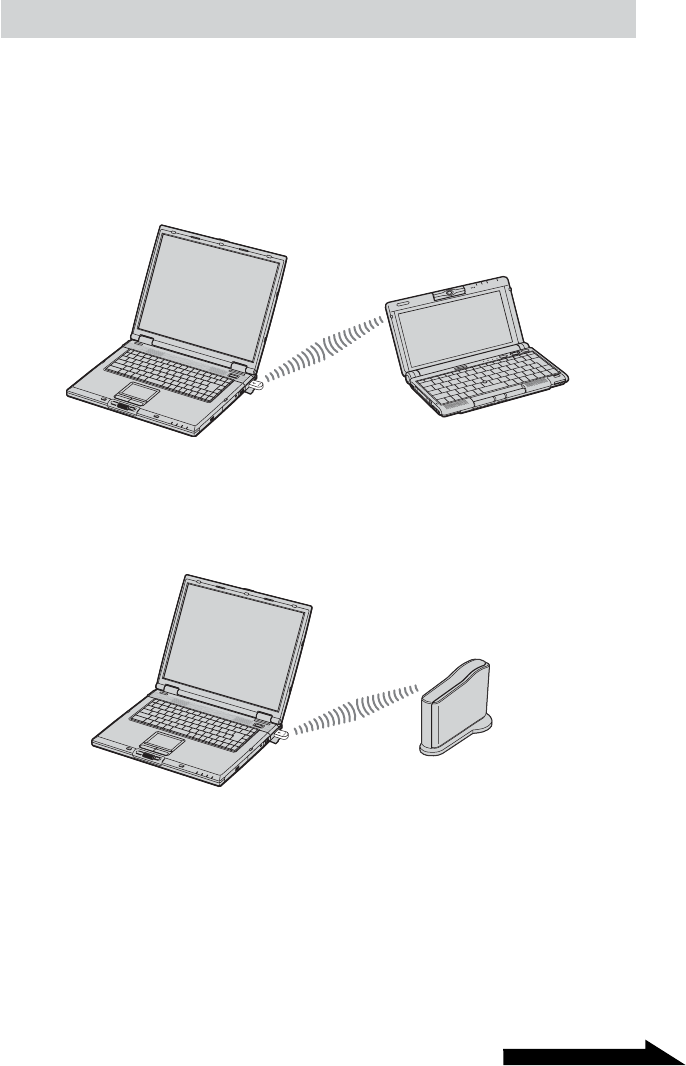
11
GB
Continued on next page
How to use this product
When the Bluetooth USB adapter is inserted into a computer, it can
exchange data with other Bluetooth technology enabled computers, mobile
phones, modems, etc. simply by being placed in the vicinity of the other
device, without any physical cable connection.
Example of use: computer to computer
Example of use: computer to Bluetooth Modem Station (or
other Bluetooth devices)
Bluetooth communications with the Bluetooth USB adapter use either the
supplied BlueSpace NE software or Windows XP functions, according to
the intended type of operation.
Computer with the
Bluetooth USB adapter
Data synchronization,
data exchange, dial-up
access, etc.
Bluetooth enabled device
(Bluetooth Modem Station:
for Europe only)
Computer with the
Bluetooth USB adapter
Data exchange, etc.
Other Bluetooth
enabled computer

12
GB
Ways to Connect with Bluetooth Devices
When connecting to a Bluetooth technology-enabled device, use one of the
following (depending on the function of the device).
•BlueSpace NE software
•Windows XP functions (Wireless Link in Control Panel)
Things you can do using the BlueSpace NE software
•Exchange files and images between computers
•Synchronize data and exchanging files and images with a PDA
•Use a camcorder or a digital still camera as a remote camera, to ex
change images
•Send images to computer or any Bluetooth device that support BIP
(Basic Image Profile)
•Bluetooth Modem Station setup (Europe only)
•Exchange addresses with cellular phones
Things you can do with the Windows XP operating system
•Connect to the Internet with a Bluetooth Modem Station (Europe only)
•Connect to the Internet with a cellular phone
•Use a mouse or keyboard
•Print text on a Bluetooth printer
To use the Bluetooth USB adapter for communication with other Bluetooth
technology enabled devices, the Bluetooth device driver and BlueSpace NE
software on the supplied CD-ROM must be installed on the computer. The
installation procedure is described in the separate “Read This First”
document.
In order to use the Bluetooth USB adapter, you must install the Bluetooth
device driver and the BlueSpace NE software contained on the supplied
CD-ROM. For instructions on how to install the software, see the separate
document “Read This First”.

13
GB
Notes
•Some Bluetooth technology enabled equipment may not function with the Bluetooth
USB adapter, depending on the type of equipment, software version, and other factors.
Before purchasing a Bluetooth technology enabled device, please check its operating
environment requirements.
For information on Bluetooth technology enabled devices, refer to “Getting Help”
(Page 31).
•You may not be able to establish a connection with a computer running a version of
BlueSpace earlier than 2.1.1. To rectify this, upgrade BlueSpace to the most recent
version.
The models below also have the following restrictions.
To be able to connect using BlueSpace NE with PCG-SR31K and PCG-C1VFK, you
must upgrade the operating system to Windows XP, and then update the BlueSpace and
the Bluetooth drivers.
For details about version updates, refer to “Getting Help” (page 31).
•BlueSpace NE does not support IP connections or chat functions. It is therefore not
possible to use these with devices running earlier versions of BlueSpace.
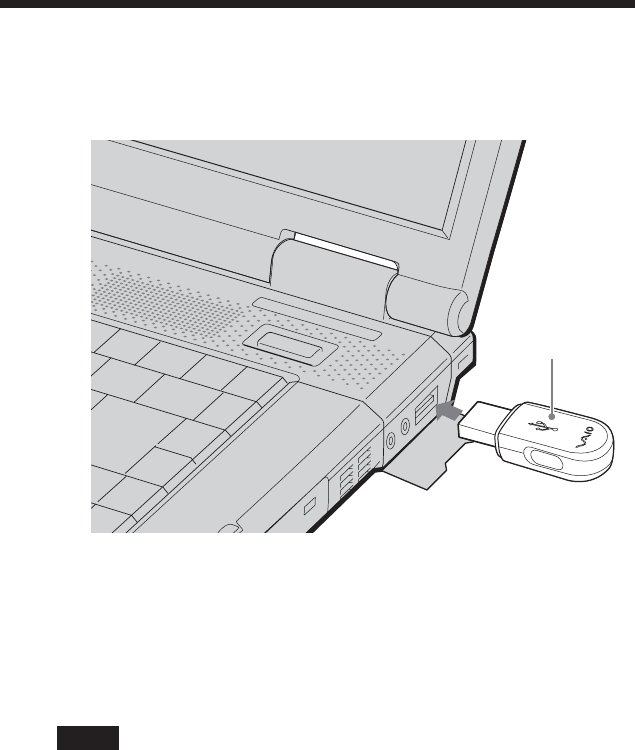
14
GB
Inserting the Bluetooth USB adapter
Insert the Bluetooth USB adapter into a USB port on the computer.
z Hint
The location of the USB port varies depending on the computer model. For details, see
the manuals provided with your computer.
When the Bluetooth USB adapter is inserted into the USB port of your
computer, it is active whenever the computer is turned on. The blue
indicator on the adapter lights up to show that the adapter is active.
Notes
•Within an aircraft and in other locations where radio emissions may be a problem,
remove the Bluetooth USB adapter from the computer. Simply shutting down the
software is not enough to stop the emission of radiowaves from the unit.
•Only one Bluetooth USB adapter can be used per computer.
•Do not insert the Bluetooth USB adapter into an external USB hub. Otherwise, software
and radio functions may not perform correctly.
Insert with “VAIO”
logo facing upwards.

15
GB
Continued on next page
Communicating using BlueSpace NE
This section describes the general procedure for using the BlueSpace NE
software installed on your computer to communicate with another
Bluetooth technology enabled device.
To communicate with other Bluetooth technology enabled devices using
BlueSpace NE, the Bluetooth device driver and BlueSpace NE software on
the supplied CD-ROM must first be installed on the computer. The
installation procedure is described in the separate “Read This First”
document.
Notes
•Some Bluetooth technology enabled equipment may not function with the Bluetooth
USB adapter, depending on the type of equipment, software version, and other factors.
Before purchasing a Bluetooth technology enabled device, please check its operating
environment requirements.
For information on Bluetooth technology enabled devices, refer to “Getting Help”
(page 31).
•You may not be able to establish a connection with a computer running a version of
BlueSpace earlier than 2.1.1. To rectify this, upgrade BlueSpace to the most recent
version.
The models below also have the following restrictions.
To be able to connect using BlueSpace NE with PCG-SR31K and PCG-C1VFK, you
must upgrade the operating system to Windows XP, and then update the BlueSpace and
the Bluetooth drivers.
For details about version updates, refer to “Getting Help” (page 31).
•BlueSpace NE does not support IP connections or chat functions. It is therefore not
possible to use these with devices running earlier versions of BlueSpace.
•You may find that some Bluetooth technology enabled devices operate differently than
described in the following procedures. Refer to the manual provided with the Bluetooth
device or Sony Bluetooth Product Information
For customers in the USA and Canada
http://www.ita.sel.sony.com/support/bluetooth/
For customers in Europe
www.vaio-link.com
For customers in other regions
http://www.css.ap.sony.com/
Refer to “Ways to Connect with Bluetooth Devices” for the types of communications
for which you can use BlueSpace NE (Page 12).
Also refer to the BlueSpace NE online help.
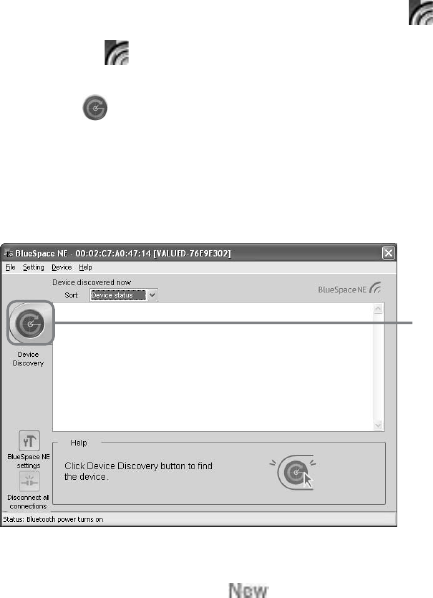
16
GB
•Do not cover the Bluetooth USB adapter while it is in use. This may interfere with
communication.
•If Wireless LAN and Bluetooth functions are used at the same time on the same
computer, communication speed may be reduced due to electromagnetic interference,
and other unwanted effects may occur.
•If a power-saving mode is enabled on one of the computers, Bluetooth communication
may not be possible. Set both computers to normal mode.
1Turn on the computer and insert the Bluetooth USB adapter
into the USB port (page 14).
2Click the “Start” button, and select “All Programs” –
“BlueSpace NE” – “BlueSpace NE”.
BlueSpace NE launches and its main window appears.
z Hint
When the “Welcome to BlueSpace NE” window appears, click “OK”.
With the factory default settings, the next time Windows starts, appears
automatically in the notification area. In this case, you can launch BlueSpace NE by
double-clicking .
3Click the (Device Discovery) button in the main window.
The computer with the Bluetooth USB adapter begins searching for
other Bluetooth technology enabled devices in the vicinity. When the
search is complete, any detected Bluetooth devices appear in the device
list.
z Hint
When a device is first detected, the mark appears on the device list in the
main window.
Click
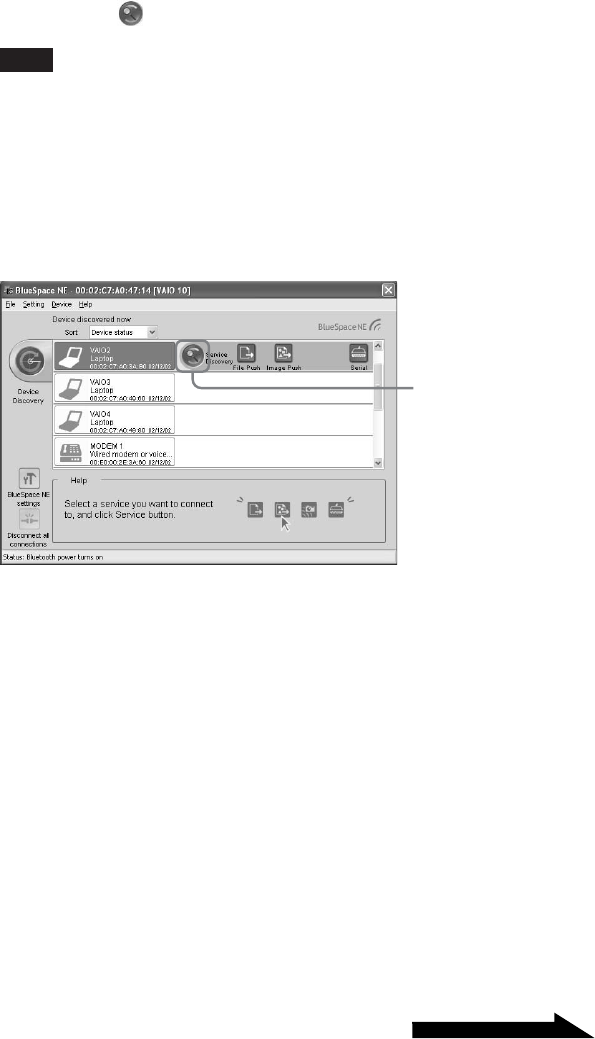
17
GB
Continued on next page
4In the device list, select the device you want to connect with,
and click the (Service Discovery) button.
Note
If authentication between devices has not been completed, a window may appear
prompting you to confirm whether you want to perform only service discovery, or
both discovery and authentication. Follow the on-screen instructions to exchange
passkeys and complete the authentication. If the authentication window does not
appear, right-click on the device to connect with, and click “Authentication”.
The computer searches for services on the selected device, and when
finished, displays icons for the available services (those supported by
both the device and BlueSpace NE).
z What is a passkey?
A passkey is a secret code entered by the user to enable two Bluetooth
devices to communicate. When the same alphanumeric string is
entered at both devices, communication becomes possible. The
passkey may be changed for every communication session. Once a
valid link has been established, communication is possible without you
having to reenter the passkey for a preset period of time.
5Select and connect to the service required.
Click

18
GB
If the “A Bluetooth device requires authentication” balloon
message appears in the notification area
The target Bluetooth technology enabled device is requesting connection
authentication. In this case, mutual authentication is required to enable
Bluetooth communications with this device.
To authenticate, click in the notification area. When the “Bluetooth
Connection Wizard” window appears, follow the on-screen instructions to
exchange passkeys.
To skip authentication, click in the balloon or “Cancel” in the
“Bluetooth Connection Wizard” window.

19
GB
Continued on next page
Communicating using Windows XP
functions
See “Ways to Connect with Bluetooth Devices” (page 12) for the types of
communication that use Windows XP functions.
To communicate using Windows XP functions, refer to the Windows XP
Wireless Link Help and the manual provided with the Bluetooth technology
enabled device.
z Hint
Before you make a dial-up connection with the Bluetooth cell phone or modem the first
time, you need to install the device as a Wireless Link, and then set up the dial-up
connection. Refer to the Windows XP Wireless Link Help for details.
To display the Windows XP Wireless Link Help.
1Click the “Start” button and click “Control Panel”.
2Click the “Printers and Other Hardware” icon.
3Click the “Wireless Link” icon.
4Double-click the “Bluetooth” tab, and click “Show Bluetooth
details ”.
If the “A Bluetooth device requires authentication” balloon
message appears in the notification area
The target Bluetooth technology enabled device is requesting connection
authentication. In this case, mutual authentication is required to enable
Bluetooth communications with this device.
To authenticate, click in the notification area. When the “Bluetooth
Connection Wizard” window appears, follow the on-screen instructions to
exchange passkeys.
To skip authentication, click in the balloon or “Cancel” in the
“Bluetooth Connection Wizard” window.

20
GB
Using a Bluetooth cell phone or modem
By using Windows XP functions to connect the Bluetooth USB adapter to a
Bluetooth cell phone or modem, dial-up communication is possible without
a connecting cable.
This section describes installation of a Bluetooth cell phone or modem, and
dial-up connection setup. For operating details, refer to the manual
provided with the Bluetooth cell phone and the Windows XP Wireless Link
Help.
Setting up a Bluetooth cell phone or modem
1Turn on the Bluetooth cell phone or modem and set it to
allow discovery.
For details, see the manual provided with the cell phone.
2Turn on the computer and insert the Bluetooth USB adapter
into the USB port (page 14).
3Click the “Start” button and select “Control Panel”.
The Control Panel appears.
4Click the “Printers and Other Hardware” icon.
5Click “Wireless Link”, and click the “Bluetooth” tab.
6Click “Add”, and then “Next” in the “Bluetooth Connection
Wizard” window.
Device discovery starts, and the Bluetooth cell phone is detected.

21
GB
Continued on next page
7Click the “Bluetooth cell phone” icon, and click “Next”.
“Authenticate the device?” appears.
Refer to the manual provided with the cell phone to determine whether
device authentication is required.
If required, perform the following steps.
8Select “Yes, authentication is required”, and click “Next”.
The message “Enter the passkey for the Bluetooth device” appears.
9If necessary, enter a passkey in the Passkey column, and
click “Next”.
Note
A passkey may be already displayed in the Bluetooth connection wizard, but
depending on your cell phone, only a certain passkey may be accepted. Follow the
instructions in your cell phone manual to enter the passkey.
10
If necessary, enter the passkey that was entered with the
connection wizard.
The message “Please specify the service to be enabled between the
device and Windows” appears.
Note
Depending on your Bluetooth cell phone, passkey entry may not be requested.
11
Select “Dial-up network (DUN)”, and click “Next”.
The “Bluetooth Connection Wizard Complete” window appears.
12
Click “Finish”.
The Bluetooth cell phone icon appears as a wireless link when
authentication is finished. Installation of the cell phone or modem is
complete.

22
GB
Preparing to make a dial-up connection
1Turn on the Bluetooth cell phone or modem and set it to
allow discovery.
For details, see the manual provided with the cell phone.
2Turn on the computer and insert the Bluetooth USB adapter
into the USB port (page 14).
3Click the “Start” button and click “Control Panel”.
4Click the “Network and Internet Connections” icon.
5Click the “Network Connections” icon.
The “Network Connections” window appears.
6Click “Create a new connection”.
The “Welcome to the New Connection Wizard” window appears.
7Click “Next”, check that “Connect to the Internet” is selected,
and click “Next”.
If the option is not selected, click so that it becomes .
When you click “Next”, the “Getting Ready” window appears.
8For the item “Set up my connection manually”, click so
that it becomes . Then click “Next”.
The “Internet Connection” window appears.
9Verify that “Connect using a dial-up modem” is checked, and
click “Next”.
If the option is not checked, click so that it becomes .
When you click “Next”, the “Select a Device” window appears.

23
GB
Continued on next page
10
Under “Select the devices to use in this connection”, click the
check box for “Standard modem over Bluetooth link”.
If another modem is selected, click the check box to deselect it.
11
Click “Next”.
The “Connection Name” window appears.
12
Enter the name to use for this connection in the “ISP Name”
(Internet Service Provider Name) field, and click “Next”.
The “Phone Number to Dial” window appears.
13
Enter the telephone number of the ISP (Internet Service
Provider) access point, and click “Next”.
The “Internet Account Information” window appears.
14
Configure “User name”, “Password” and “Confirm
password”, and click “Next”.
The “Completing the New Connection Wizard” window appears.
15
Click “Finish”.
Establishing a dial-up connection
1Click the “Start” button, then click “Control Panel” – “Network
and Internet Connections” – “Network Connections”.
The “Network Connections” window appears.
2Double-click the icon of the connection destination created in
the “Create a new connection” procedure.
3Click “Dial”.
The dial-up connection is established via the Bluetooth connection.

24
GB
Terminating a dial-up connection
Right-click * in the task bar, and select “Disconnect” from the menu.
* The icon appearing in the task bar looks just like the icon of the connected wireless
network device. You can check the name of the connected device by moving the
pointer to the icon in the task bar.
For information on how to terminate Bluetooth communication, see
“Terminating Bluetooth communication” (page 25).
Assigning/changing the Bluetooth device name for
the computer
The computer name to be displayed when detected by another Bluetooth
technology enabled device can be set using Windows XP functions.
1Turn on the computer and insert the Bluetooth USB adapter
into the USB port (page 14).
2Click the “Start” button, and click “Control Panel”.
The Control Panel appears.
3Click the “Printers and Other Hardware” icon.
4Click the “Wireless Link” icon.
5Click the “Hardware” tab.
6Select “Sony Bluetooth USB Adapter”, and click “Properties”.
The “Sony Bluetooth USB Adapter Properties” window appears.
7Click the “Advanced” tab.
8Change the “Name”, and click “OK”.
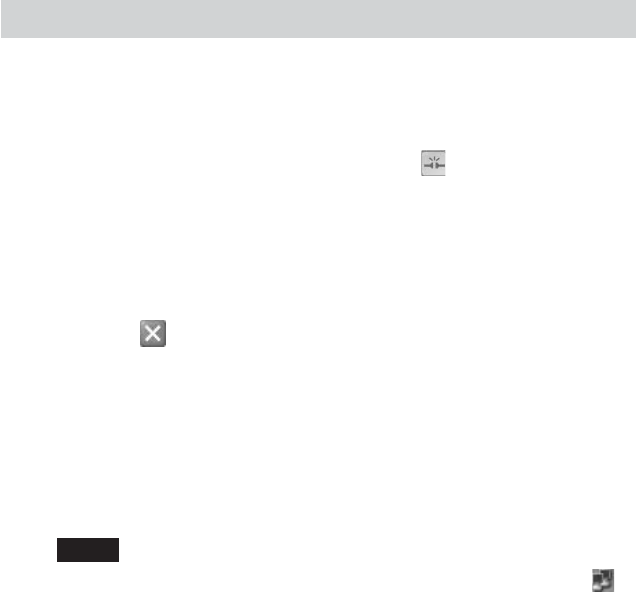
25
GB
Terminating Bluetooth communication
While communicating using BlueSpace NE
1Click the connected service button appearing in the
BlueSpace NE main window, or click (“Disconnect all
connections” button).
A confirmation window appears.
2Click “Yes”.
3Click in the top right-hand corner of the window to close
the BlueSpace NE main window.
4Remove the Bluetooth USB adapter from the USB port.
While communicating using Windows XP functions
Remove the Bluetooth USB adapter from the USB port.
Notes
When the computer is connected to the Bluetooth cell phone or modem, right-click *
in the task bar, and select “Disconnect” from the menu to terminate the dial-up connection
first. Then perform the following steps to terminate Bluetooth communication.
* The icon appearing in the task bar looks just like the icon of the connected wireless
network device. You can check the name of the connected device by moving the
pointer over the icon in the task bar.
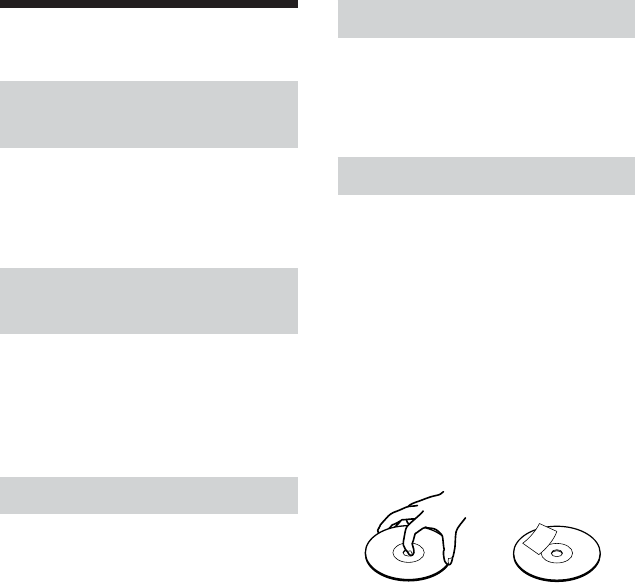
26
GB
Notes on Use
Protect the unit from
shock
To prevent the possibility of damage,
take care not to drop the unit or
otherwise subject it to strong shocks.
Usage and storage
locations
Do not use or store this unit in
locations subject to high humidity,
high temperatures, strong vibrations,
direct sunlight, or high levels of dust.
Operation
•Do not place any objects on top of
the unit.
•Protect the unit from sudden
temperature changes. Do not use the
unit immediately after moving it
from a cold to a warm location or
after the ambient temperature has
risen drastically. Otherwise
condensation inside the unit can
occur. If the temperature has
changed significantly during
operation, turn off the power of the
unit and let it stand for about an
hour.
Transport
Retain the packing material of the unit
and reuse it when transporting the unit
again.
Notes on discs
On handling discs
•To keep the disc clean, handle only
by the edges. Do not touch the
surface.
•Do not write on or stick paper or
tape to the surface of the disc.
•Do not use a disc with tape, seals, or
paste on it. Such a disc may damage
the disc drive.
On safekeeping
•Do not expose the disc to direct
sunlight or heat sources such as hot
air ducts, or leave it in a car parked
in direct sunlight.
•After playing, store the disc in its
case. Stocking discs without cases
or leaving the disc exposed, may
cause damage to the disc.
On cleaning
•Fingerprints, dust or dirt can cause
reading errors or reduced sound
quality. Always keep the disc clean.
Correct Incorrect
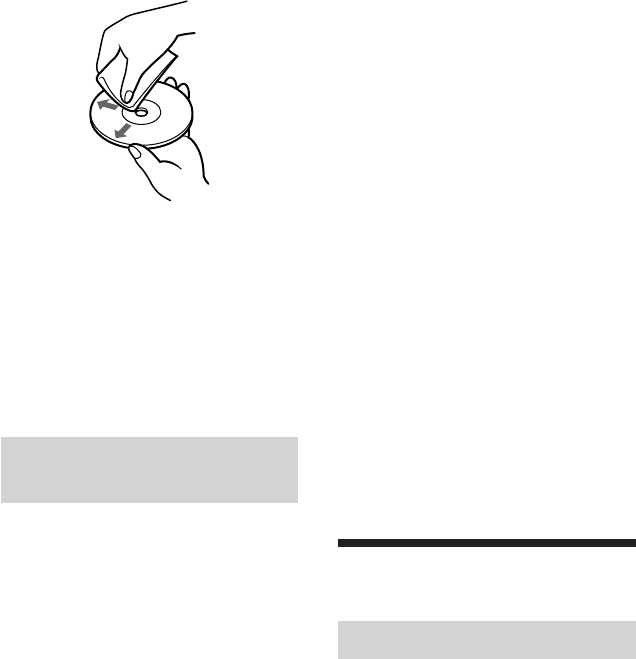
27
GB
•Clean the disc with a duster. Wipe
the disc from the center out.
•To remove dirt, clean the disc with a
soft cloth slightly moistened with
water, then remove the moisture
with a soft dry cloth.
•Do not use solvents such as benzine,
thinner, commercially available
cleaners or antistatic spray intended
for vinyl LPs.
Bluetooth
communications
•The 2.4 GHz band used by
Bluetooth and wireless LAN devices
is also used by various other
devices. Bluetooth devices
incorporate technology that
minimizes interference from other
devices using the same wavelength.
However, communication speed and
achievable distances may be
reduced. Interference from other
devices can also stop
communications altogether.
•The data transfer rate will vary
depending on distance and obstacles
between devices, device
configuration, radio interference,
operating system, software
application, etc. In some cases,
communication may be interrupted.
•Communication range will vary
according to whether walls or other
obstacles are located between
devices, the material used in walls,
the presence of radio frequency
interference and other
environmental conditions, and the
type of software being used.
•If Wireless LAN and Bluetooth
functions are used at the same time
on the same computer,
communication speed may be
reduced due to electromagnetic
interference, and other unwanted
effects may occur.
•Please note that due to limitations of
the Bluetooth standard, large files
may occasionally be corrupted
during continuous transfer due to
electromagnetic interference from
the environment.
Maintenance
Cleaning the case
•Wipe the outside of the unit with a
soft, dry cloth. To remove stains,
moisten the cloth with a mild,
neutral detergent. Do not use
solvents, cleaning alcohol, benzine
or other substances that may damage
the finish.
•Fingerprints and smudges can be
removed by wiping with a lens
cleaning cloth.
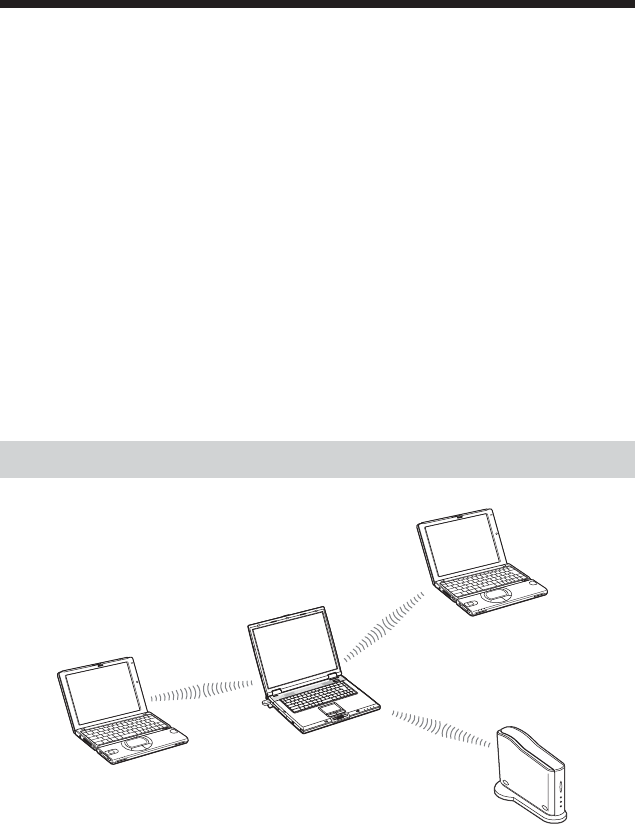
28
GB
Bluetooth Wireless Technology
Bluetooth wireless technology is a new development that is about to
revolutionize the field of personal networks. As a world-wide standard for
short-range, low-cost wireless communications, Bluetooth compatibility
will be integrated in a wide variety of devices, allowing notebooks, mobile
phones and other mobile equipment to communicate with each other and
access the Internet.
The Bluetooth SIG (Special Interest Group) comprises electronics and
communications equipment manufacturers and other leading companies in
the fields of computing and networking. The SIG has worked out the
technological standards for Bluetooth communications. Many Bluetooth
technology compatible products are now being developed and brought onto
the market. Along with Sony, the Bluetooth SIG comprises more than 2000
companies worldwide including major computer and communications
equipment manufacturers as well as household appliance manufacturers.
Connection format
Using Bluetooth, the notebook in which this device is installed can
communicate wirelessly with nearby peripheral devices (with no
interconnecting cables).
In addition, files can be exchanged wirelessly between the notebook in
which this device is installed and other Bluetooth-enabled computers or
digital cameras.
To establish a wireless connection between the notebook in which this
device is installed and another Bluetooth-enabled device, each device must
support a common set of functions (profile).

29
GB
Speed
Bluetooth communications support a maximum data transfer rate of
723 kbps, but actual data transfer rates will vary, depending on factors such
as distance and obstacles between devices, radio interference, the operating
system or the software used, as well as equipment sensitivity and the
performance of the aerial. Data transfer rates are optimized to achieve the
best throughput under a given set of conditions.
Communication range and power
Bluetooth enabled devices are divided into several categories. Power Class
1 devices can communicate within a 10 to 100 meter range*. Power Class 2
or 3 devices can communicate within a 10 meter range*.
The Bluetooth USB adapter is a Power Class 2 device.
*This assumes that no obstacles are present.
Communication range will vary according to whether walls or other obstacles are
located between devices, the material used in walls, the presence of radio frequency
interference and other environmental conditions, and the type of software being used.
Bluetooth standard
In order to facilitate communication between Bluetooth technology
compatible devices from various manufacturers, the Bluetooth SIG has
worked out standards regarding wireless transfer methods, security
implementation, application specific data formats, etc. All Bluetooth
technology compatible devices must be certified according to procedures
approved by the Bluetooth SIG to make sure that applicable standard
requirements are met.
However, even if standard requirements are met, individual device
performance and specifications as well as operation procedures vary, which
means that data exchange may not be possible in all cases.

30
GB
Security
Bluetooth wireless communications implement an authentification feature
that can be used to prevent unauthorized access from unidentified Bluetooth
devices. The first time two Bluetooth devices communicate with each other,
a common passkey must be entered before the two devices are allowed to
exchange data. Once a connection has been established, communication
between the devices can proceed for a preset interval (default setting in
BlueSpace software: indefinite), without the need to reenter the passkey.
The Bluetooth USB adapter can be set up so as not to be discovered by
other Bluetooth devices. For information on how to set the device
information storage period and how to set not respond to the device
discovery from remote devices, refer to the help function of the
BlueSpace NE software.

31
GB
Getting Help
This section describes how to get help and support from Sony, as well as
troubleshooting tips for your Bluetooth USB Adapter.
About Sony’s Support Options
Sony provides following support options for your Bluetooth USB Adapter.
If you have questions about your Bluetooth USB Adapter and the software,
check these places for answers:
❑Read This First explains how to install the software before using
Bluetooth USB Adapter.
❑This guide explains how to use your Bluetooth USB Adapter.
For customers in the United States and Canada
❑The Sony Customer Information Service Center offers
information about your notebook and other Sony products that work with
your computer. To contact Sony Customer Information Service Center,
call 1-888-4SONYPC (1-888-476-6972).
❑The Sony fax-back service provides you with answers to frequently
asked questions. You can use this automated service to request a list of
available topics and then select the topics that you want to receive. To
contact the Sony fax-back service, call
1-888-4SONYPC (1-888-476-6972).
❑The Sony e-mail support service answers your questions by
electronic mail. Just send your question in an
e-mail message, and a customer service representative will send you a
reply. To send a question to Sony e-mail support, address the message to
SOS@info.sel.sony.com.
❑The Sony website provides the latest information on your products.
http://www.ita.sel.sony.com/support/
For customers in Europe
❑Support service. For addresses and numbers, refer to your Customer
Service Guide.
www.vaio-link.com
For customers in other regions
❑VAIO Website provides Frequently Asked Questions and solutions.
vaio-online.sony.com/

32
GB
Specifications
Wireless communications
Communication method
Bluetooth standard Ver. 1.1
Maximum data transfer rate 1)
Approx. 723 kbps
Output
Bluetooth standard Power Class 2
Communication range 2)
Up to 10 m
Supported Bluetooth profiles 3)
Generic Access Profile
Service Discovery Application Profile
Serial Port Profile
Dial-up Networking Profile
Generic Object Exchange Profile
Object Push Profile
Basic Imaging Profile
Hardcopy Cable Replacement Profile
Human Interface Device Profile
Frequency band
2.4 GHz band (2.400 GHz - 2.4835 GHz)
1) Data transfer rate will vary depending on
distance and obstacles between devices, device
configuration, radio interference, operating
system, software application, etc. In some
cases, communication may be interrupted.
2) Communication range will vary according to
whether walls or other obstacles are located
between devices, the material used in walls,
the presence of radio frequency interference
and other environmental conditions, and the
type of software being used.
3) Bluetooth standard profiles specify the usage
purpose for Bluetooth devices communicating
with each other.
General
Interface
USB
Dimensions
Approx.
0.7 × 0.4 × 1.7 in. (17.0 × 8.5 × 41.3 mm)
(w/h/d)
Mass
Approx. 0.1 oz (5.0 g)
Ambient conditions for
operation and storage
Operating temperature
5°C to 35°C
(temperature gradient less than 10°C/hour)
Operating humidity
20% to 80% (not condensed),
provided that humidity is less than 65% at 35°C
(hygrometer reading of less than 29°C)
Storage temperature
-20°C to 60°C
(temperature gradient less than 10°C/hour)
Storage humidity
10% to 90% (not condensed),
provided that humidity is less than 20% at 60°C
(hygrometer reading of less than 35°C)
Design and specifications are subject to change
without notice.

33
GB
Continued on next page
Troubleshooting
If a problem occurs during operation of the unit, please check the points
listed in this troubleshooting guide. If the problem persists, contact support
service. For contact information, see “Getting Help” on page 31.
You should also consult the manuals provided with your computer.
Symptom Cause/Remedy
No communication
targets listed. Bluetooth
communication not
possible.
cMake sure that the Bluetooth USB adapter is properly
inserted in the USB port.
cMake sure that the Bluetooth USB adapter is not covered.
cCommunication is possible only within a range of about 10
meters. If devices are further away, move them closer
together.
cCommunication range may be less than 10 meters,
depending on factors such as the presence of obstacles
between devices, radio interference, wall and other
materials, and the type of software application. Try moving
the computer with the Bluetooth USB adapter or the other
device.
cIf a power-saving mode is enabled at the computer with the
Bluetooth USB adapter, correct Bluetooth communication
may not be possible. Set the computer to normal mode.
cCheck whether the Bluetooth function is enabled at the
target device, and whether normal mode is selected. If a
power-saving mode is enabled on the target device, correct
Bluetooth communication may not be possible.
cCheck whether the Bluetooth function is turned on at the
connection target device. For details, see the
documentation of the device.
cIf the intended target device is currently communicating
with another device, it may not be listed as an available
device, and communication with the computer with the
Bluetooth USB adapter may not be possible.
cThe name of the Bluetooth enabled device at the
communication destination may have been changed since
the previous device discovery. Delete all devices that have
been discovered using the BlueSpace NE software, and
restart to perform device discovery again.
For more details, see the Help information for the
BlueSpace NE software.

34
GB
Symptom Cause/Remedy
No communication
targets listed. Bluetooth
communication not
possible.
Data transfer speed is
low.
Cannot connect to
service supported by
target Bluetooth
device.
An error message
appears and dial-up
connection cannot be
established by the
Bluetooth cell phone or
modem.
cIf this device is connected to a computer serving as the
slave, it will be unable to communicate with other devices.
Terminate the current communications link (page 25), and
reconnect from the computer to which this device is
connected.
cMake sure that the computer with the Bluetooth USB
adapter is not covered.
cData transfer speed may be affected by factors such as the
distance and presence of obstacles between devices, radio
interference, walls and other materials, and the type of
software application. Try moving the computer with the
Bluetooth USB adapter or the other device.
cConnection is possible only to a service also supported by
the computer with the Bluetooth USB adapter.
For details, see BlueSpace NE help and the manual
provided with the target Bluetooth device.
cThe previous connection may not have been properly
terminated. After restarting the computer to which the
Bluetooth USB adapter is connected, try establishing the
dial-up connection again.
c The modem may not be properly installed.
See “Setting up a Bluetooth cell phone or modem” (page
20) to reinstall the modem.
When you have finished the reinstallation perform the
following steps in order.
1Restart the computer to which the Bluetooth USB
adapter is connected.
2Click the “Start” button, and click “Control Panel”.
The Control Panel appears.
3Click the “Network and Internet Connections” icon.
4Click the “Network Connections” icon.
The “Network Connections” window appears.
5Double-click the connection target icon.
6In the “Connect to ...” window (where “...” is the name
of the connection destination), click “Properties”, and in
the “General” tab, place a check mark by “Standard
modem over Bluetooth link”, so that is it shown at the
top of the “List” tab.
7Click “OK”.
8Click “Dial” again to establish the dial-up connection.
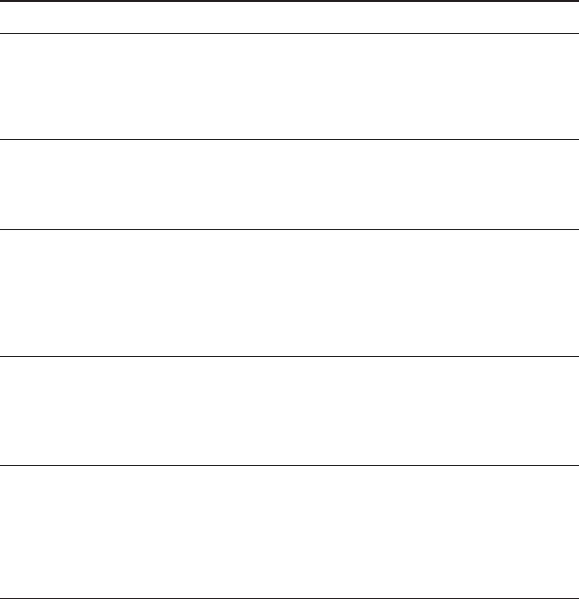
35
GB
Symptom Cause/Remedy
File exchange with
another VAIO
computer is not
possible.
The computer with the
Blutooth USB adapter
installed does not go
into standby mode.
Bluetooth
communication fails
midway.
The message “The
Bluetooth device
requires authentication”
appears in the
notification area.
The authentication
window does not
appear even when
performing Service
Discovery on a non-
authenticated device.
cIf an older version of the BlueSpace software is being used
problems with the file transfer service may occur. Make
sure that the BlueSpace software and the Bluetooth device
driver on the target are the latest versions. For information
on upgrading software refer to the VAIO-Link website.
cSwitching to standby mode automatically is not possible if
the computer is communicating with other Bluetooth
devices. To enter standby mode, terminate all Bluetooth
communications.
cRemove Bluetooth USB adapter from the USB connector,
then plug it back into the connector and try Bluetooth
communication again.
Other devices located in the vicinity of Wireless LAN
communication can cause Bluetooth communication to fail
midway.
cThe target Bluetooth enabled device is requesting
connection authentication. Mutual authentication is
required to enable Bluetooth communications with this
device. Refer to “Communicating using Windows XP
functions” (page 19) for details.
cAuthentication may not have been performed during
previous Service Discovery. Right-click on the device
connected via BlueSpace NE, and click “Authentication”.
2
DE
Bevor Sie den PCGA-BA1 benutzen,
lesen Sie unbedingt den im
Lieferumfang enthaltenen
Endbenutzerlizenzvertrag.
❑Die Software und das mitgelieferte
Handbuch sind urheberrechtlich
geschützt. Ohne die Zustimmung
des Urheberrechtsinhabers dürfen
sie weder ganz noch auszugsweise
reproduziert werden. Auch ein
Verleih der Software ist untersagt.
❑Unter keinen Umständen haftet
Sony für irgendwelche finanziellen
Schäden oder entgangenen Gewinn,
einschließlich aller Ansprüche
Dritter, die auf die Verwendung der
mit dem Laufwerk gelieferten
Software zurückgehen.
❑Wenn an diesem Produkt aufgrund
eines Fabrikationsfehlers ein
Problem auftritt, wird das Produkt
von Sony ersetzt. Weitergehende
Haftungsansprüche gegenüber Sony
bestehen nicht.
❑Die mit diesem Gerät gelieferte
Software kann nicht mit anderen
Geräten eingesetzt werden.
❑Wir sind um eine stetige
Verbesserung unserer Produkte
bemüht. Beachten Sie deshalb bitte,
dass sich die Software-
Spezifikationen ohne Ankündigung
ändern können.
❑Der Betrieb des Geräts mit anderer
als der mitgelieferten Software ist
durch die Garantie nicht abgedeckt.
Warnhinweise
❑Zur Vermeidung von elektrischen
Schlägen darf das Gehäuse nicht
geöffnet werden. Reparaturarbeiten
sind ausschließlich von autorisierten
Fachleuten durchzuführen.
❑Zur Vermeidung von Feuer und
elektrischen Schlägen darf das Gerät
weder Regen noch Feuchtigkeit
ausgesetzt werden.
❑In bestimmten Situationen oder
Umgebungen ist die Verwendung
der Bluetooth™-Technologie
möglicherweise durch Vorgaben des
Gebäudeeigentümers oder des
zuständigen Vertreters der
betreffenden Organisation
eingeschränkt. Dies betrifft unter
Umständen den Einsatz in
Flugzeugen, in Krankenhäusern
oder in anderen Umgebungen, wo
die möglichen Folgen einer Störung
anderer Geräte oder Dienste für
schwerwiegend erachtet werden.
❑Besteht Unkenntnis über die
Bedingungen für den Einsatz der
Bluetooth™-Technologie in einer
bestimmten Organisation oder
Umgebung, wird dringend
empfohlen, vor der Inbetriebnahme
der Geräte zunächst eine
entsprechende Genehmigung
einzuholen.
❑Weiterhin ist es ratsam,
gegebenenfalls vor dem Einsatz der
Bluetooth™-Technologie den Rat
eines Arztes oder Herstellers eines
am Körper getragenen
medizinischen Gerätes (z. B.
Herzschrittmacher oder Hörhilfe)
einzuholen.

3
DE
Sicherheits-
standards
Hiermit erklärt Sony, dass der
PCGA-BA1 Bluetooth™ USB-
Adapter den grundlegenden
Anforderungen und anderen
relevanten Vorgaben der europäischen
Richtlinie 1999/5/EG entspricht.
PCGA-BA1 Bluetooth™ ist ein für die
Energieklasse 2 vorgesehenes
Funkgerät für den Frequenzbereich 2,4
GHz (2,400 GHz - 2,4835GHz). Das
Gerät ist für die drahtlose
Datenübertragung mit anderen Geräten
mit Bluetooth™-Funktion unter
Verwendung der Profile Bluetooth™,
für den seriellen Anschluss, die DFÜ-
Netzwerkverbindung über
Mobiltelefon oder Modem, Object
Push und Basic Imaging geeignet.
Bluetooth-USB-Adapter entspricht den
Anforderungen sämtlicher
einschlägiger Sicherheitsstandards in
den folgenden Ländern:
Belgien, Dänemark, Deutschland,
Finnland, Frankreich,
Griechenland, Großbritannien,
Italien, Irland, Island, Luxemburg,
Niederlande, Norwegen, Österreich,
Portugal, Schweden, Schweiz und
Spanien.
Im Frankreich lässt sich dieses
Produkt nur im Haus verwerden.
Der PCGA-BA1 Bluetooth™
USB-Adapter entspricht EN 55022
Klasse B und EN 55024 für die
Verwendung in folgenden Bereichen:
Wohngebiete, Büros und
Industriegebiete geringer Dichte.
DE
•VAIO und sind
eingetragene Warenzeichen der
Sony Corporation.
•Microsoft und Windows sind
eingetragene Warenzeichen der
Microsoft Corporation in den USA
und/oder anderen Ländern.
•BLUETOOTH und das
entsprechende Logo sind
Warenzeichen der Bluetooth SIG,
Inc., USA, und werden von der
Sony Corporation als Lizenznehmer
verwendet.
•Andere in dieser Anleitung erwähnte
System- und Produktnamen sind in
der Regel eingetragene
Warenzeichen oder Warenzeichen
der jeweiligen Unternehmen, auch
wenn sie in dieser Anleitung nicht
mit ™ und ® gekennzeichnet sind.
•In dieser Bedienungsanleitung
werden die Microsoft® Windows®
XP Home Edition und Microsoft®
Windows® XP Professional kurz
Windows XP genannt.

4
DE
Inhaltsverzeichnis
Einführung .........................................5
Wie dieses Gerät benutzt wird ..7
Möglichkeiten der Verbindung
zu Bluetooth-Geräten............. 8
Einsetzen des
Bluetooth USB-Adapters ............10
Kommunikation über
BlueSpace NE .............................11
Kommunikation über
Windows XP-Funktionen ...........15
Verwenden eines Bluetooth-
Handys oder -Modems ........16
Zuweisung eines
Bluetooth-Gerätenamens an
den Computer/Ändern des
Bluetooth-Gerätenamens .....21
Beenden der Bluetooth-
Datenübertragung ................22
Sicherheitsmaßnahmen ....................23
Wartung ...........................................25
Drahtlose Bluetooth Technologie .... 26
Anschlussformat...................... 26
Geschwindigkeit...................... 27
Kommunikationsreichweite und
Leistung ...............................27
Bluetooth Standard .................. 27
Sicherheit .........................................28
Hilfeinformationen und
technische Unterstützung ............29
Technische Daten ............................30
Fehlerbehebung ...............................31

5
DE
Bitte wenden
Einführung
Bei diesem Gerät handelt es sich um einen USB-Adapter für Computer, die
keine eingebauten Bluetooth-Funktionen besitzen. Der Adapter ermöglicht
einen drahtlosen Datenaustausch mit anderen Geräten, die Bluetooth
ebenfalls unterstützen.
z Drahtlose Bluetooth-Technologie
Mit der drahtlosen Bluetooth-Technologie kann über kurze Entfernungen rasch eine
Verbindung zu anderen Geräten hergestellt werden, und das ohne lästigen Kabelsalat.
Weitere Informationen darüber finden Sie im Abschnitt „Drahtlose Bluetooth
Technologie“ auf Seite 26.
Mit welchen Computermodellen kann der Bluetooth USB-
Adapter PCGA-BA1 benutzt werden?
Mit Sony VAIO-Notebooks, auf denen Windows XP läuft (außer mit
Modellen mit eingebauter Bluetooth-Funktion).
Windows XP Service Pack 1 muss installiert sein. Überprüfen Sie die
Betriebssystemversion und aktualisieren Sie gegebenenfalls das
Betriebssystem. Nähere Informationen hierzu finden Sie in dem
Dokument „Bitte zuerst lesen“.
Hinweis
Weitere Informationen über VAIO-Computer, die Bluetooth unterstützen, finden Sie
unter „Hilfeinformationen und technische Unterstützung“ (Seite 29).
Leistungsmerkmale
•Mit Bluetooth ist ein drahtloser Datenaustausch in einem Bereich von bis
zu 10 Metern möglich. (Die Kommunikationsreichweite hängt von
eventuellen Hindernissen wie Wänden o. ä. zwischen den Geräten, dem
Material der Wände, eventuellen Funkstörungen und anderen
Umgebungsbedingungen sowie der verwendeten Software ab.)
•Sicherheitsfunktionen verhindern einen Datenaustausch mit nicht
identifizierten Bluetooth-Geräten. Ausführliche Informationen darüber
finden Sie im Abschnitt „Sicherheit“ auf Seite 28.
6
DE
Mit welchen Bluetooth-Geräten kann der Bluetooth USB-
Adapter Daten austauschen?
(Stand: Mai 2003)
•Mit Sony VAIO-Notebooks mit eingebauter Bluetooth-Funktion (für
Europa)
•Mit anderen Sony VAIO-Notebooks, auf denen Windows XP läuft und
an denen ein PCGA-BA1 Bluetooth USB-Adapter installiert ist
•Mit anderen Sony-Produkten, die Bluetooth verwenden
Informieren Sie sich über die Bluetooth-Funktionen, die Ihr Bluetooth-
Gerät unterstützt.
z Tipp
Die Software-CD-ROM enthält im Ordner „manual“ eine Kopie dieses Handbuchs und des
Dokuments „Bitte zuerst lesen“ im PDF-Format.
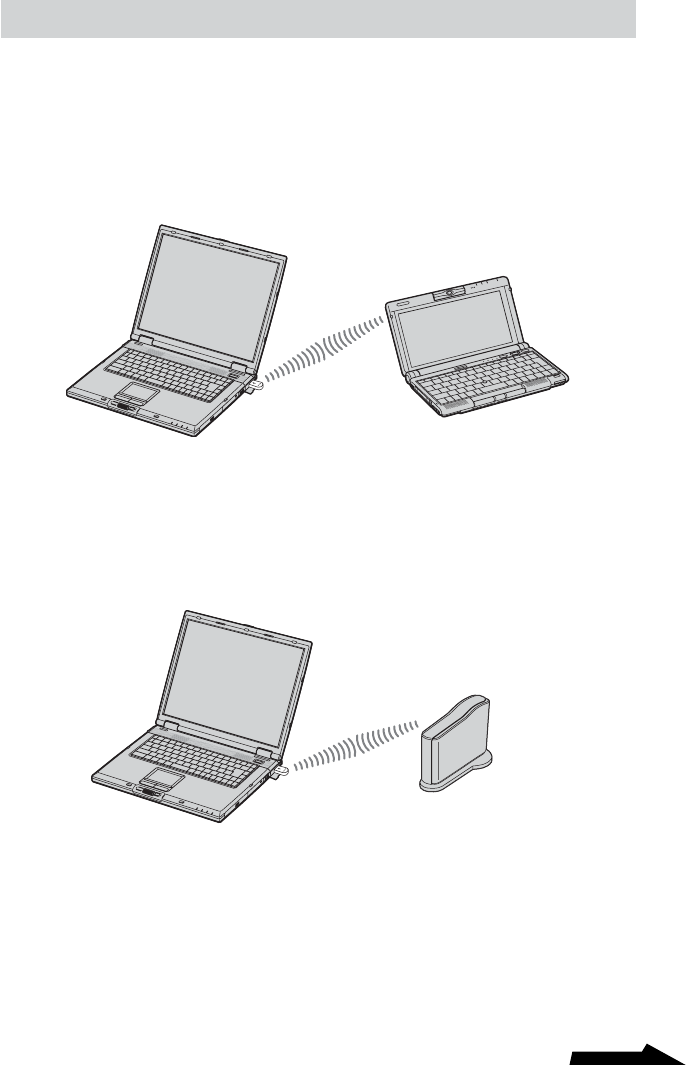
7
DE
Bitte wenden
Wie dieses Gerät benutzt wird
Sobald der Bluetooth USB-Adapter in einen Computer eingesetzt ist, ist ein
Datenaustausch mit anderen Bluetooth-fähigen Geräten wie Computern,
Mobiltelefonen, Modems usw. möglich. Kabelverbindungen sind nicht
erforderlich, stellen Sie die Geräte einfach in die Nähe des Computers.
Einsatzbeispiel (Datenaustausch mit einem Computer)
Beispiel für den Einsatz mit Bluetooth-Geräten wie der
Bluetooth Modemstation
Je nach gewünschter Betriebsart werden für die Bluetooth-Kommunikation
über den Bluetooth USB-Adapter die mitgelieferte BlueSpace NE-Software
oder Windows XP-Funktionen verwendet.
Computer mit installiertem
Bluetooth USB-Adapter
Datenaustausch usw.
Anderer
Bluetooth-fähiger
Computer
Computer mit installiertem
Bluetooth USB-Adapter
Datensynchronisation,
Datenaustausch,
Einwahlvorgang usw.
Bluetooth-fähiges Gerät
(Bluetooth-Modemstation:
nur für Europa)

8
DE
Möglichkeiten der Verbindung zu Bluetooth-Geräten
Zum Herstellen einer Verbindung zu einem Bluetooth-fähigen Gerät haben
Sie je nach Funktionsweise des Geräts die folgenden Möglichkeiten.
•BlueSpace NE-Software
•Windows XP-Funktionen (drahtlose Verbindung in der Systemsteuerung)
Diese Möglichkeiten haben Sie bei der BlueSpace NE-Software:
•Austausch von Dateien und Bildern zwischen Computern
•Synchronisation von Daten sowie Austausch von Dateien und Bildern
mit einem PDA (Personal Digital Assistant)
•Verwenden eines Camcorders oder einer digitalen Standbildkamera als
ferne Kamera für den Austausch von Bildern
•Senden von Bildern an eine Kamera oder ein anderes Bluetooth-Gerät,
das BIP (Basic Image Profile) unterstützt
•Konfiguration einer Bluetooth-Modemstation (nur Europa)
•Austausch von Adressen mit Mobiltelefonen
Diese Möglichkeiten haben Sie mit dem Betriebssystem
Windows XP:
•Herstellen einer Internet-Verbindung mit einer Bluetooth-Modemstation
(nur Europa)
•Herstellen einer Internet-Verbindung über ein Mobiltelefon
•Verwenden einer Maus oder Tastatur
•Drucken auf einem Bluetooth-Drucker
Das Verfahren zum Herstellen einer Verbindung hängt von der
verwendeten Software ab. Die einzelnen Verfahren sind im Folgenden
erläutert.
Damit der Bluetooth USB-Adapter verwendet werden kann, müssen der auf
der mitgelieferten CD-ROM enthaltene Bluetooth-Gerätetreiber und die
BlueSpace-Software installiert werden. Wie diese Software installiert wird,
entnehmen Sie dem Dokument „Bitte zuerst lesen“.

9
DE
Hinweise
•Abhängig vom Gerätetyp, der Software-Version und anderen Faktoren kann es sein,
dass einige Bluetooth-Geräte mit der Bluetooth USB-Adapter keine Daten austauschen
können. Bevor Sie ein Bluetooth-fähiges Gerät erwerben, sollten Sie sich über dessen
Betriebsumgebung und Systemvoraussetzungen informieren.
Informationen über Bluetooth-Geräte finden Sie unter „Hilfeinformationen und
technische Unterstützung“ (Seite 29).
•Zu einem Computer, auf dem eine frühere BlueSpace-Version als 2.1.1 läuft, kann
möglicherweise keine Verbindung hergestellt werden. Aktualisieren Sie BlueSpace auf
die neueste Version, um dieses Problem zu beheben.
Für die Modelle unten gelten außerdem die folgenden Einschränkungen.
Damit bei den Modellen PCG-SR31K und PCG-C1VFK über BlueSpace NE eine
Verbindung hergestellt werden kann, müssen Sie auf das Betriebssystem Windows XP
aufrüsten und dann BlueSpace und die Bluetooth-Treiber aktualisieren.
Nähere Informationen zu Updates finden Sie unter „Hilfeinformationen und technische
Unterstützung“ (Seite 29).
•BlueSpace NE bietet keine Unterstützung für IP-Verbindungen und Chatfunktionen. Es
ist daher nicht möglich, diese mit Geräten zu verwenden, auf denen frühere Versionen
von BlueSpace laufen.
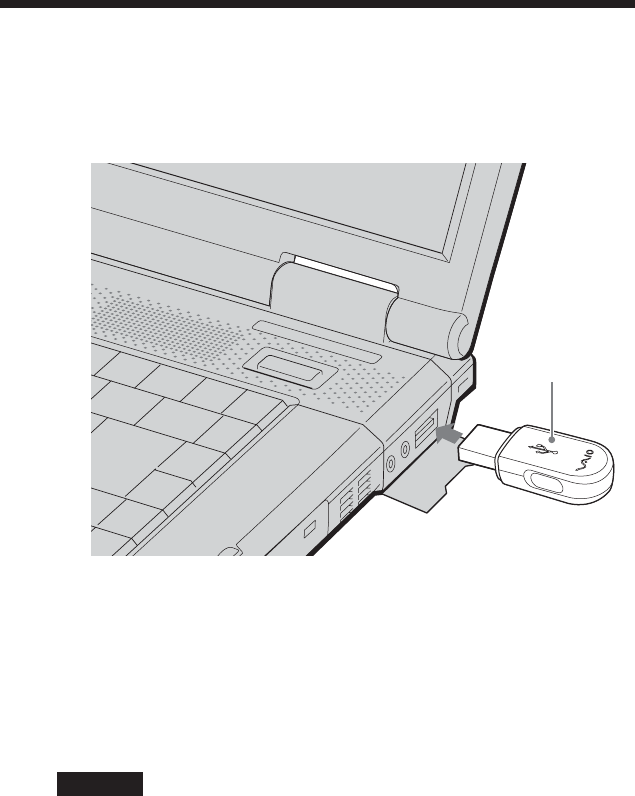
10
DE
Einsetzen des Bluetooth USB-Adapters
Schieben Sie den Bluetooth USB-Adapter in einen USB-Anschluss Ihres
Computers.
z Tipp
Wo sich der USB-Anschluss befindet, hängt vom jeweiligen Computermodell ab.
Informationen dazu finden Sie im Handbuch Ihres Computers.
Wenn der Bluetooth USB-Adapter am USB-Anschluss Ihres Computers
angesteckt ist, ist er nach dem Einschalten des Computers immer aktiv.
Wenn die blaue Anzeige auf dem Adapter leuchtet bedeutet dies, dass der
Adapter aktiv ist.
Hinweise
•In Flugzeugen oder an anderen Orten, an denen Funkwellen Probleme verursachen
können, sollten Sie den Bluetooth USB-Adapter vom Computer abziehen. Einfaches
Herunterfahren der Software genügt nicht, um das Aussenden von Funkwellen zu
beenden.
•Pro Computer kann nur ein Bluetooth USB-Adapter verwendet werden.
•Schieben Sie den Bluetooth USB-Adapter nicht in einen externen USB-Hub ein.
Ansonsten kann eine einwandfreie Funktion der Software und ein zuverlässiger
Datenaustausch nicht garantiert werden.
Mit dem „VAIO“-
Logo nach oben
einsetzen.

11
DE
Bitte wenden
Kommunikation über BlueSpace NE
Dieser Abschnitt erklärt die grundlegenden Schritte für einen
Datenaustausch mit anderen Geräten die Bluetooth unterstützen.
Bevor der Bluetooth USB-Adapter benutzt werden kann, müssen der auf
der mitgelieferten CD-ROM enthaltene Bluetooth-Gerätetreiber und die
BlueSpace-Software installiert werden. Wie diese Software installiert wird,
entnehmen Sie dem Dokument „Bitte zuerst lesen!“.
Hinweise
•Abhängig vom Gerätetyp, der Software-Version und anderen Faktoren kann es sein,
dass einige Bluetooth-Geräte mit der Bluetooth USB-Adapter nicht funktionieren.
Bevor Sie ein Bluetooth-Gerät erwerben, sollten Sie sich über dessen
Betriebsumgebung und Systemvoraussetzungen informieren.
Informationen über Bluetooth-Geräte finden Sie unter „Hilfeinformationen und
technische Unterstützung“ (Seite 29).
•Zu einem Computer, auf dem eine frühere BlueSpace-Version als 2.1.1 läuft, kann
möglicherweise keine Verbindung hergestellt werden. Aktualisieren Sie BlueSpace auf
die neueste Version, um dieses Problem zu beheben.
Für die Modelle unten gelten außerdem die folgenden Einschränkungen.
Damit bei den Modellen PCG-SR31K und PCG-C1VFK über BlueSpace NE eine
Verbindung hergestellt werden kann, müssen Sie auf das Betriebssystem Windows XP
aufrüsten und dann BlueSpace und die Bluetooth-Treiber aktualisieren.
Nähere Informationen zu Updates finden Sie unter “Hilfeinformationen und technische
Unterstützung” (Seite 29).
•BlueSpace NE bietet keine Unterstützung für IP-Verbindungen und Chatfunktionen. Es
ist daher nicht möglich, diese mit Geräten zu verwenden, auf denen frühere Versionen
von BlueSpace laufen.
•Möglicherweise arbeiten einige Bluetooth-fähigen Geräte anders als in den folgenden
Verfahren beschrieben. Schlagen Sie bitte im Handbuch zum Bluetooth-Gerät oder in
den Sony-Bluetooth-Produktinformationen nach
Für Kunden in den USA und Kanada
http://www.ita.sel.sony.com/support/bluetooth/
Für Kunden in Europa
www.vaio-link.com
Für Kunden in anderen Regionen
http://www.css.ap.sony.com/
Unter „Möglichkeiten der Verbindung zu Bluetooth-Geräten“ finden Sie Informationen
zu den Kommunikationstypen, für die Sie BlueSpace NE verwenden können (Seite 8).
Schlagen Sie dazu auch in der Online-Hilfe zu BlueSpace NE nach.
• Decken Sie den Bluetooth USB-Adapter nicht ab, wenn Sie das Gerät verwenden.
Andernfalls kann die Kommunikation beeinträchtigt werden.
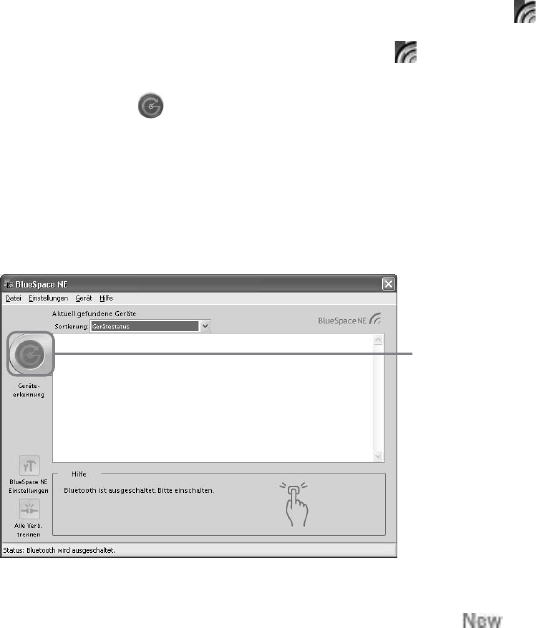
12
DE
•Wenn auf dem selben Computer gleichzeitig eine drahtlose LAN- und Bluetooth
Datenübertragung erfolgt, kann dies aufgrund von elektromagnetischen Störungen die
Geschwindigkeit der Datenübertragung verringern und andere unerwünschte
Auswirkungen haben.
•Wenn auf einem der Computer eine Stromsparfunktion aktiviert ist, ist ein
Datenaustausch über Bluetooth eventuell nicht möglich. Aktivieren Sie auf beiden
Computern den normalen Modus.
1Schalten Sie den Computer ein und stecken Sie den
Bluetooth USB-Adapter an den USB-Anschluss an (Seite 10).
2Klicken Sie auf die Schaltfläche „Start“ und wählen Sie „Alle
Programme“ – „BlueSpace NE“ – „BlueSpace NE“.
BlueSpace NE wird gestartet und das Hauptfenster wird angezeigt.
z Tipp
Klicken Sie auf „OK“, wenn das Fenster „Willkommen bei BlueSpace NE“
angezeigt wird.
Sofern die werkseitigen Standardeinstellungen nicht geändert werden, erscheint
automatisch im Infobereich, wenn Windows das nächste Mal gestartet wird. In
diesem Fall können Sie BlueSpace NE starten, indem Sie auf doppelklicken.
3Klicken Sie auf (Geräteerkennungs-Schaltfläche) im
Hauptfenster.
Der Computer, in den der Bluetooth USB-Adapter eingesetzt ist,
beginnt automatisch mit der Suche nach anderen Bluetooth-fähigen
Geräten in der Nähe. Sobald die Suche abgeschlossen ist, werden alle
erkannten Bluetooth-Geräte in der Geräteliste angezeigt.
z Tipp
Wenn ein Gerät zum ersten Mal erkannt wird, erscheint die Markierung in der
Geräteliste im Hauptfenster.
Hier klicken
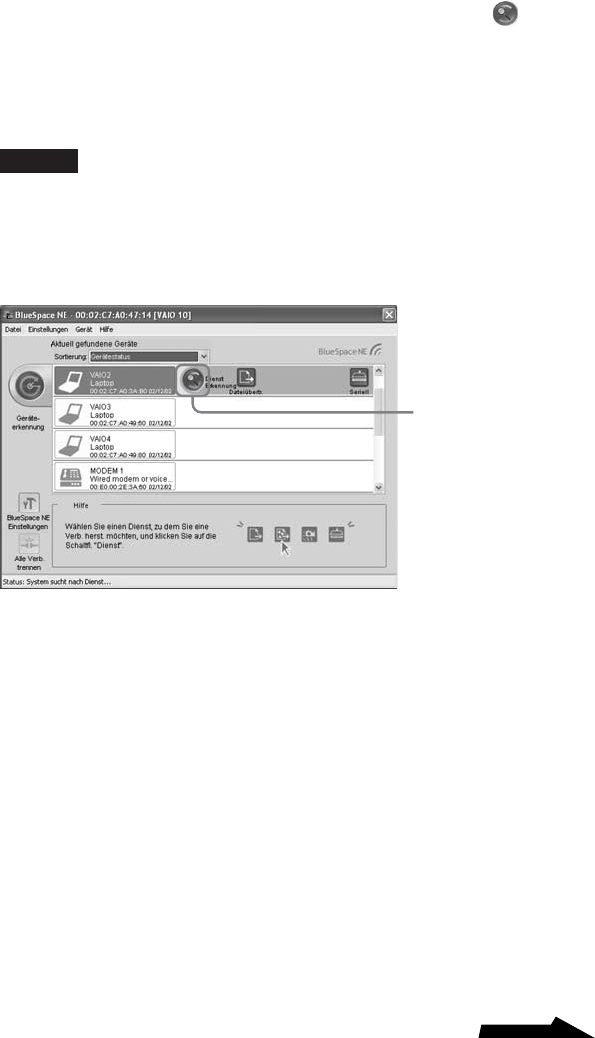
13
DE
Bitte wenden
4Wählen Sie in der Geräteliste das Gerät aus, mit dem eine
Verbindung hergestellt werden soll, und klicken Sie auf
(Diensterkennungs-Schaltfläche).
Der Computer sucht auf dem ausgewählten Gerät nach Diensten und
danach werden Symbole für die verfügbaren Dienste (Dienste, die vom
Gerät und von BlueSpace NE unterstützt werden) angezeigt.
Hinweis
Wenn die Authentifizierung zwischen den Geräten nicht abgeschlossen wird, wird
möglicherweise ein Fenster angezeigt und Sie werden gefragt, ob nur die
Diensterkennung oder die Diensterkennung und die Authentifizierung vorgenommen
werden sollen. Gehen Sie zum Austauschen von Passwörtern und zum Abschließen
der Authentifizierung nach den Anweisungen auf dem Bildschirm vor.
z Was ist ein Passwort?
Ein Passwort ist ein geheimer vom Benutzer eingegebener Code, der es
zwei Bluetooth-Geräten ermöglicht, Daten auszutauschen. Erst wenn
an beiden Geräten die selbe alphanumerische Zeichenkette (Code)
eingegeben wird, ist eine Datenübertragung möglich. Sie können
jedesmal ein anderes Passwort benutzen, wenn Sie eine Verbindung zu
einem Gerät herstellen. Sobald die Verbindung steht, können Daten
ausgetauscht werden, ohne für eine im Vorhinein eingestellte
Zeitspanne das Passwort erneut eingeben zu müssen.
5Wählen Sie den Dienst aus, der verwendet werden soll, und
stellen Sie die Verbindung her.
Hier klicken

14
DE
Wenn im Infobereich eine Sprechblase mit der Meldung „Ein
Bluetooth-Gerät erfordert Authentifizierung“ angezeigt wird
Das Bluetooth-fähige Zielgerät fordert eine Verbindungsauthentifizierung
an. In diesem Fall ist eine gegenseitige Authentifizierung erforderlich,
damit eine Bluetooth-Kommunikation stattfinden kann.
Klicken Sie im Infobereich auf , um die Authentifizierung vorzunehmen.
Wenn das Fenster „Bluetooth Verbindungs Assistent“ angezeigt wird,
gehen Sie zum Austauschen von Passwörtern wie in den Anweisungen auf
dem Bildschirm erläutert vor.
Wenn Sie die Authentifizierung auslassen möchten, klicken Sie in der
Sprechblase auf oder im Fenster „Bluetooth Verbindungs Assistent“
auf „Abbrechen“.

15
DE
Bitte wenden
Kommunikation über Windows XP-
Funktionen
Bei welchen Kommunikationsarten Windows XP-Funktionen verwendet
werden, ist unter „Möglichkeiten der Verbindungsherstellung zu Bluetooth-
Geräten“ (Seite 8) erläutert.
Weitere Informationen zur Kommunikation über Windows XP-Funktionen
finden Sie in der Windows XP-Hilfe zur drahtlosen Verbindung und dem
Handbuch zu dem Bluetooth-fähigen Gerät.
z Tipp
Bevor Sie zum ersten Mal eine DFÜ-Verbindung mit einem Bluetooh-Handy oder -
Modem herstellen können, müssen Sie das Gerät als drahtlose Verbindung installieren
und dann die DFÜ-Verbindung konfigurieren. Nähere Informationen finden Sie in der
Windows XP-Hilfe zur drahtlosen Verbindung.
Anzeigen der Windows XP-Hilfe zur drahtlosen Verbindung
1Klicken Sie auf die Schaltfläche „Start“ und dann auf
„Systemsteuerung“.
2Klicken Sie auf das Symbol „Drucker und andere Hardware“.
3Klicken Sie auf das Symbol „Drahtlose Verbindung“.
4Doppelklicken Sie auf die Registerkarte „Bluetooth“ und klicken
Sie auf „Bluetooth-Details anzeigen“.
Wenn im Infobereich eine Sprechblase mit der Meldung „Ein
Bluetooth-Gerät erfordert Authentifizierung“ angezeigt wird
Das Bluetooth-fähige Zielgerät fordert eine Verbindungsauthentifizierung
an. In diesem Fall ist eine gegenseitige Authentifizierung erforderlich,
damit eine Bluetooth-Kommunikation stattfinden kann.
Klicken Sie im Infobereich auf , um die Authentifizierung vorzunehmen.
Wenn das Fenster „Bluetooth Verbindungs Assistent“ angezeigt wird,
gehen Sie zum Austauschen von Passwörtern wie in den Anweisungen auf
dem Bildschirm erläutert vor.
Wenn Sie die Authentifizierung auslassen möchten, klicken Sie in der
Sprechblase auf oder im Fenster „Bluetooth Verbindungs Assistent“
auf „Abbrechen“.

16
DE
Verwenden eines Bluetooth-Handys oder -Modems
Wenn Sie über Windows XP-Funktionen eine Verbindung zwischen dem
Bluetooth USB-Adapter und einem Bluetooth-Handy oder -Modem
herstellen, können Sie ohne Verbindungskabel eine DFÜ-Verbindung
aufbauen.
In diesem Abschnitt wird die Installation eines Bluetooth-Handy bzw. -
Modems und die Konfiguration der DFÜ-Verbindung beschrieben. Nähere
Informationen finden Sie in dem Handbuch zum verwendeten Bluetooth-
Handy bzw. -Modem sowie in der Windows XP-Hilfe zur drahtlosen
Verbindung.
Konfigurieren eines Bluetooth-Handys bzw. -Modems
1Schalten Sie das Bluetooth-Handy bzw. -Modem ein und
stellen Sie es so ein, dass eine Erkennung möglich ist.
Einzelheiten entnehmen Sie bitte den Handbüchern zu dem Bluetooth-
Handy bzw. -Modem.
2Schalten Sie den Computer ein und setzen Sie den
Bluetooth USB-Adapter in den USB-Anschluss ein.
3Klicken Sie auf die Schaltfläche „Start“ und wählen Sie
„Systemsteuerung“.
Die Systemsteuerung wird angezeigt.
4Klicken Sie auf das Symbol „Drucker und andere Hardware“.
5Klicken Sie auf „Drahtlose Verbindung“ und dann auf die
Registerkarte „Bluetooth“.
6Klicken Sie auf „Hinzufügen“ und dann im Fenster „Bluetooth
Verbindungs Assistent“ auf „Weiter“.
Die Geräteerkennung beginnt und das Bluetooth-Handy bzw. -Modem
wird erkannt.

17
DE
Bitte wenden
7Klicken Sie auf das Symbol „Mobiltelefonen“ und dann auf
„Weiter“.
„Die Meldung „Soll das Gerät authentifiziert werden?“ wird angezeigt.
Ob eine Geräteauthentifizierung erforderlich ist, entnehmen Sie bitte
dem Handbuch zu dem verwendeten Handy.
Führen Sie gegebenfalls die folgenden Schritte aus.
8Wählen Sie „Ja, dieses Gerät erfordert eine
Authentifizierung, bevor es verwendet werden kann“ und
klicken Sie auf „Weiter“.
Die Meldung „Geben Sie einen Hauptschlüssel für das Bluetooth-Gerät
ein“ wird angezeigt.
9Geben Sie gegebenenfalls ein Passwort in das Feld
„Passwort“ ein und klicken Sie auf „Weiter“.
Hinweis
Im Bluetooth-Verbindungsassistenten wird möglicherweise bereits ein Passwort
angezeigt, doch je nach Handy wird eventuell nur ein bestimmtes Passwort
akzeptiert. Gehen Sie zum Eingeben des Passworts nach den Anweisungen im
Handbuch zu dem Handy vor.
10
Geben Sie gegebenenfalls über den
Verbindungsassistenten das Passwort ein.
Die Meldung "Geben Sie bitte den zwischen dem Gerät und Windows
zu aktivierenden Dienst an" wird angezeigt.
Hinweis
Je nach verwendetem Bluetooth-Handy ist eine Passworteingabe möglicherweise
nicht erforderlich.
11
Wählen Sie „DFÜ-Netzwerk“ und klicken Sie auf „Weiter“.
Das Fenster „Bluetooth-Verbindungs-Assistent“ wird angezeigt.
12
Klicken Sie auf „Fertigstellen“.
Das Symbol für das Mobiltelefonen erscheint als drahtlose
Verbindung, sobald die Authentifizierung abgeschlossen ist. Die
Installation des Handys bzw. Modems ist damit beendet.

18
DE
Vorbereitungen zum Herstellen einer DFÜ-Verbindung
1Schalten Sie das Bluetooth-Handy bzw. -Modem ein und
stellen Sie es so ein, dass eine Erkennung möglich ist.
Einzelheiten entnehmen Sie bitte den Handbüchern zu dem Bluetooth-
Handy bzw. -Modem.
2Schalten Sie den Computer ein und setzen Sie den
Bluetooth USB-Adapter in den USB-Anschluss ein.
3Klicken Sie auf die Schaltfläche „Start“ und anschließend auf
„Systemsteuerung“.
4Klicken Sie auf das Symbol „Netzwerk-und
Internetverbindungen“.
5Klicken Sie auf das Symbol „Netzwerkverbindungen“.
Das Fenster „Netzwerkverbindungen“ wird angezeigt.
6Klicken Sie auf „Neue Verbindung erstellen“.
Das Fenster „Willkommen“ wird angezeigt.
7Klicken Sie auf „Weiter“, vergewissern Sie sich, dass
„Verbindung mit dem Internet herstellen“ markiert ist, und
klicken Sie auf „Weiter“.
Ist diese Option nicht markiert, klicken Sie auf , so dass es als
angezeigt wird.
Wenn Sie auf „Weiter“ klicken, wird das Fenster „Vorbereitung“
angezeigt.
8Für den Punkt „Verbindung manuell einrichten“ klicken Sie
auf , so dass es als angezeigt wird. Klicken Sie
anschließend auf „Weiter“.
Das Fenster „Internetverbindung“ wird angezeigt.

19
DE
Bitte wenden
9Vergewissern Sie sich, dass der Punkt „Verbindung mit
einem DFÜ-Modem herstellen“ markiert ist, und klicken Sie
auf „Weiter“.
Ist diese Option nicht markiert, klicken Sie auf , so dass es als
angezeigt wird.
10
Klicken Sie auf das Kontrollkästchen für "Standardmodem
über Bluetooth-Verbindung (COMx)".
Ist ein anderes Modem gewählt, klicken Sie auf dessen Markierung,
um die Auswahl aufzuheben.
11
Klicken Sie auf „Weiter“.
Das Fenster „Verbindungsname“ wird angezeigt.
12
Geben Sie in das Feld „Name des Internetdienstanbieters“
einen Namen für diese Verbindung ein und klicken Sie auf
„Weiter“.
Das Fenster „Zu wählende Rufnummer“ wird angezeigt.
13
Geben Sie die Einwahlnummer Ihres Internetdienstanbieters
ein, und klicken Sie auf „Weiter“.
Das Fenster „Internetkontoinformationen“ wird angezeigt.
14
Nehmen Sie die Eingaben für „Benutzername“, „Kennwort“
und „Kennwort bestätigen“ vor, und klicken Sie auf „Weiter“.
Das Fenster „Fertigstellen des Assistenten“ wird angezeigt.
15
Klicken Sie auf „Fertigstellen“.

20
DE
Herstellen einer DFÜ-Verbindung
1Klicken Sie auf die Schaltfläche „Start“ und dann auf
„Systemsteuerung“ – „Netzwerk-und Internetverbindungen“
– „Netzwerkverbindungen“.
Das Fenster „Netzwerkverbindungen“ wird angezeigt.
2Doppelklicken Sie auf das Symbol für das Verbindungsziel,
das Sie mit dem Verfahren „Neue Verbindung erstellen“
erstellt haben.
3Klicken Sie auf „Wählen“.
Die DFÜ-Verbindung wird über die Bluetooth-Verbindung hergestellt.
Beenden einer DFÜ-Verbindung
Klicken Sie die rechte Maustaste auf * in der Taskleiste und wählen Sie
im angezeigten Menü „Verbindung trennen“.
*Das in der Taskleiste angezeigte Symbol sieht wie das Symbol für ein angeschlossenes
drahtloses Netzwerkgerät aus. Wenn Sie mit dem Mauszeiger in der Taskleiste auf
dieses Symbol zeigen, wird der Name des angeschlossenen Geräts angezeigt.
Informationen über das Beenden einer Bluetooth-Verbindung finden Sie
unter „Beenden der Bluetooth-Datenübertragung“ (Seite 22).

21
DE
Bitte wenden
Zuweisung eines Bluetooth-Gerätenamens an den
Computer/Ändern des Bluetooth-Gerätenamens
Der Computername, der angezeigt werden soll, wenn ein anderes
Bluetooth-fähiges Gerät den Computer erkannt, kann über die Windows
XP-Funktionen eingestellt werden.
1Schalten Sie den Computer ein und stecken Sie den
Bluetooth USB-Adapter an den USB-Anschluss an (Seite 10).
2Klicken Sie auf die Schaltfläche „Start“ und dann auf
„Systemsteuerung“.
Die Systemsteuerung wird angezeigt.
3Klicken Sie auf das Symbol „Drucker und andere Hardware“.
4Klicken Sie auf das Symbol „Drahtlose Verbindung“.
5Klicken Sie auf die Registerkarte „Hardware“.
6Wählen Sie „Sony Bluetooth USB Adapter“ und klicken Sie
auf „Eigenschaften“.
Das Fenster „Eigenschaften von Sony Bluetooth USB Adapter“ wird
angezeigt.
7Klicken Sie auf die Registerkarte „Details“.
8Ändern Sie unter „Name“ den Namen und klicken Sie auf
„OK“.
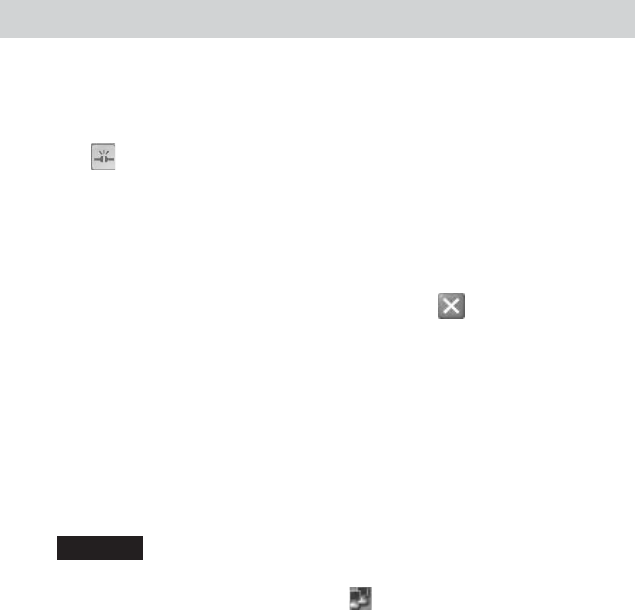
22
DE
Beenden der Bluetooth-Datenübertragung
Bei der Kommunikation über BlueSpace NE
1Klicken Sie im BlueSpace NE-Fenster auf die Schaltfläche
für den verbundenen Dienst.
Ein Bestätigungsfenster erscheint.
2Klicken Sie auf „Ja“.
3Klicken Sie oben rechts im Fenster auf , um das
BlueSpace NE-Fenster zu schließen.
4Nehmen Sie den Bluetooth USB-Adapter vom USB-
Anschluss ab.
Bei der Kommunikation über Windows XP-Funktionen
Nehmen Sie den Bluetooth USB-Adapter vom USB-Anschluss ab.
Hinweise
•Wenn der Computer mit dem Bluetooth-Handy bzw. -Modem verbunden ist, klicken
Sie zunächst mit der rechten Maustaste auf
* in der Taskleiste und wählen Sie im
Menü „Verbindung trennen“, um die DFÜ-Verbindung zu beenden. Anschließend
beenden Sie die Bluetooth-Datenübertragung wie nachstehend erklärt.
* Das in der Taskleiste angezeigte Symbol sieht wie das Symbol für ein
angeschlossenes drahtloses Netzwerkgerät aus. Wenn Sie mit dem Mauszeiger in der
Taskleiste auf dieses Symbol zeigen, wird der Name des angeschlossenen Geräts
angezeigt.
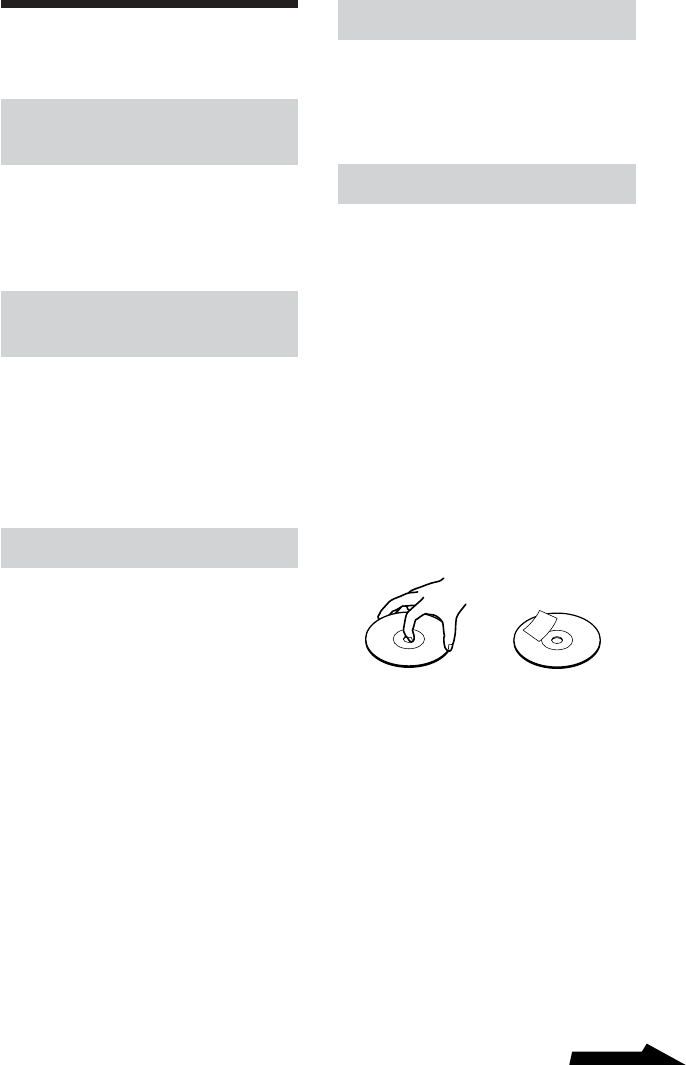
23
DE
Bitte wenden
Sicherheitsmaßnahmen
Schützen Sie das Gerät
vor Stößen
Um Schäden zu vermeiden, achten Sie
darauf, das Gerät nicht fallen zu
lassen, und schützen Sie es vor starken
Stößen.
Geeignete Umgebungen
für Betrieb und Lagerung
Verwenden oder lagern Sie dieses
Gerät nicht an Orten, an denen es
hoher Luftfeuchtigkeit, hohen
Temperaturen, starken Vibrationen,
direktem Sonnenlicht oder übermäßig
viel Staub ausgesetzt ist.
Betrieb
•Stellen Sie keine Gegenstände auf
das Gerät.
•Schützen Sie das Gerät vor starken
Temperaturschwankungen.
Verwenden Sie das Gerät nicht
unmittelbar, nachdem Sie es von
einem kalten an einen warmen Ort
gebracht haben oder nachdem die
Umgebungstemperatur drastisch
angestiegen ist. Andernfalls kann
sich im Gerät Feuchtigkeit
niederschlagen. Wenn sich die
Temperatur während des Betriebs
erheblich ändert, schalten Sie das
Gerät aus und lassen es etwa eine
Stunde lang stehen.
Transport
Bewahren Sie das
Verpackungsmaterial des Geräts auf,
und verwenden Sie es, wenn das Gerät
wieder transportiert werden soll.
Hinweise zu CDs
Umgang mit CDs
•Fassen Sie CDs nur am Rand an,
damit sie nicht verschmutzen.
Berühren Sie nicht die Oberfläche
einer CD.
•
Schreiben Sie nichts auf die CD, und
kleben Sie weder Papier noch
Klebeband auf die Oberfläche der CD.
•Verwenden Sie keine CD, auf der
sich Aufkleber, Klebstoff o. ä.
befindet. Bei einer solchen CD kann
das CD-ROM-Laufwerk beschädigt
werden.
Aufbewahrung
• Setzen Sie die CD weder direktem
Sonnenlicht noch Wärmequellen
wie zum Beispiel
Warmluftauslässen aus. Lassen Sie
sie auch nicht in einem in der Sonne
geparkten Auto liegen.
•Bewahren Sie CDs nach der
Wiedergabe immer in ihrer Hülle
auf. Wenn Sie CDs ohne Hülle
stapeln und ungeschützt lassen,
können sie beschädigt werden.
Richtig Falsch
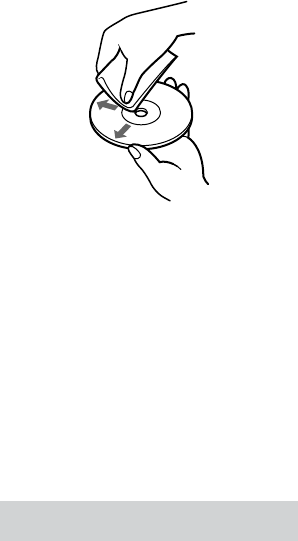
24
DE
Reinigung
•Fingerabdrücke, Staub oder
Schmutz können Lesefehler
verursachen oder die Tonqualität
beeinträchtigen. Halten Sie CDs
daher immer sauber. Halten Sie die
CD sauber.
•Reinigen Sie die CD mit einem
Reinigungstuch. Wischen Sie dabei
von der Mitte nach außen.
•Wenn die CD verschmutzt ist,
reinigen Sie sie mit einem weichen
Tuch, das Sie leicht mit Wasser
angefeuchtet haben. Wischen Sie sie
anschließend mit einem weichen,
trockenen Tuch trocken.
•Verwenden Sie keine Lösungsmittel
wie Benzin oder Verdünner und
keine handelsüblichen
Reinigungsmittel oder Antistatik-
Sprays für Schallplatten.
Bluetooth Kommunikation
•Das 2,4-GHz-Band, das von
Bluetooth und drahtlosen LAN-
Geräten verwendet wird, wird auch
von verschiedenen anderen Geräten
genutzt. Bluetooth kompatible
Geräte bedienen sich einer
Technologie, die die Interferenzen
von anderen Geräten mit der
gleichen Wellenlänge möglichst
weitgehend unterdrückt.
Allerdings kann es zu einer
Beeinträchtigung der
Übertragungsgeschwindigkeit und
der Reichweite kommen.
Interferenzen von anderen Geräten
können unter Umständen sogar zum
vollständigen Abbruch einer
Kommunikation führen.
•
Die Datenübertragungsgeschwindigkeit
richtet sich nach der Entfernung,
eventuellen Hindernissen zwischen den
Geräten, der Gerätekonfiguration,
Funkstörungen, dem Betriebssystem,
der verwendeten Anwendung usw.
•Die Kommunikationsreichweite
hängt von eventuellen Hindernissen
wie Wänden o. ä. zwischen den
Geräten, dem Material der Wände,
eventuellen Funkstörungen und
anderen Umgebungsbedingungen
sowie der verwendeten Software ab.
•Wenn auf dem selben Computer
gleichzeitig eine drahtlose LAN-
und Bluetooth Datenübertragung
erfolgt, kann dies aufgrund von
elektromagnetischen Störungen die
Geschwindigkeit der
Datenübertragung verringern und
andere unerwünschte Auswirkungen
haben.
•Wegen bestimmter
Einschränkungen des Bluetooth-
Standards, kann es beim
fortlaufenden Übertragen von
großen Dateien aufgrund von außen
kommenden elektromagnetische
Störungen zu Datenfehlern
kommen, wodurch die übertragenen
Dateien fehlerhaft sind.

25
DE
Wartung
Reinigen des Gehäuses
•Reinigen Sie das Gehäuse des
Geräts mit einem weichen,
trockenen Tuch. Zum Entfernen
hartnäckiger Verschmutzungen
feuchten Sie das Tuch mit einem
milden, neutralen Reinigungsmittel
an. Verwenden Sie keine
Lösungsmittel wie Alkohol, Benzin
oder andere Substanzen, die die
Oberfläche angreifen könnten.
•Fingerabdrücke und Flecken können
auch mit einem
Objektivreinigungstuch entfernt
werden.
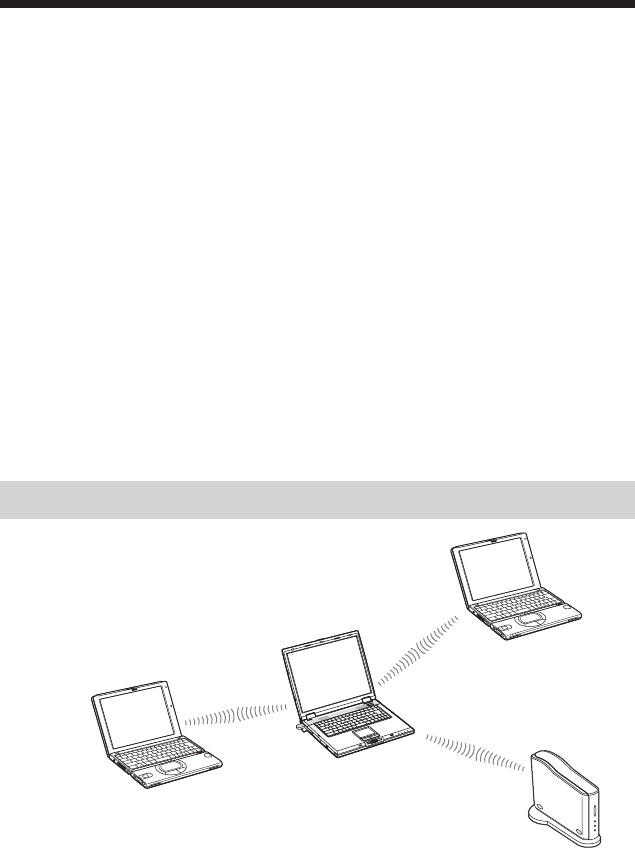
26
DE
Drahtlose Bluetooth Technologie
Die drahtlose Bluetooth Technologie ist ein neuer Kurzstrecken-
Funkstandard, der die Netzwerkkommunikation über kurze Entfernungen
revolutionieren wird. Als weltweiter Standard für kostengünstige
Funkkommunikation über kurze Strecken wird die Bluetooth
Kompatibilität in Zukunft in viele verschiedene Geräte integriert sein, so
dass Notebook Computer, Mobiltelefone und andere tragbaren Geräte
miteinander kommunizieren können und Zugriff auf das Internet haben.
In der Bluetooth SIG (Special Interest Group) sind Hersteller von
Elektronik- und Kommunikationsgeräten sowie führende Computer- und
Netzwerkunternehmen vereinigt. Die SIG hat die technologischen
Standards für die Bluetooth Kommunikation erarbeitet. Viele Bluetooth
fähigen Produkte werden nun entwickelt und kommen derzeit auf den
Markt. Unter anderen auch mit Sony umfasst die Bluetooth SIG mehr als
2000 Unternehmen weltweit, einschließlich wichtiger Computer- und
Kommunikationsgerätehersteller sowie Hersteller von Haushaltsgeräten.
Anschlussformat
Ein mit dem Bluetooth-Adapter ausgestattetes Notebook kann über kurze
Entfernungen drahtlos mit Peripheriegeräten kommunizieren (ohne
Verbindungskabel).
Auch Dateien können drahtlos zwischen einem mit dem Bluetooth-Adapter
gestatteten Notebook und anderen Bluetooth fähigen Computern oder
Kameras ausgetauscht werden.

27
DE
Voraussetzung für einen Datenaustausch zwischen einem Notebook, in dem
der Bluetooth-Adapter installiert ist, und anderen Bluetooth fähigen
Geräten ist, dass beide Geräte die selben Bluetooth-Funktionen (Profil)
unterstützen.
Geschwindigkeit
Bei der Bluetooth Kommunikation wird eine maximale
Datenübertragungsrate von 723 Kbps unterstützt. Die tatsächlichen
Datenübertragungsraten hängen jedoch von verschiedenen Faktoren ab,
z. B. von der Entfernung, ob Hindernisse zwischen den Geräten vorhanden
sind, ob Radio-Interferenzen auftreten, welches Betriebssystem bzw.
welche Software verwendet wird sowie von der Geräteempfindlichkeit und
der Antennenleistung. Die Datenübertragungsraten werden dahingehend
optimiert, dass bei bestimmten Gegebenheiten der beste Durchsatz erzielt
wird.
Kommunikationsreichweite und Leistung
Bluetooth-fähige Geräte werden in mehrere Klassen unterteilt. Geräte der
Power Class 1 können innerhalb eines Bereichs von 10 bis 100 Metern*
miteinander kommunizieren. Geräte der Power Class 2 und 3 können
innerhalb eines Bereichs von 10 Metern* miteinander kommunizieren. Der
Bluetooth USB-Adapter ist ein Gerät der Power Class 2.
*Vorausgesetzt, dass keine Hindernisse vorhanden sind.
Die Kommunikationsreichweite hängt von eventuellen Hindernissen wie Wänden o. ä.
zwischen den Geräten, dem Material der Wände, eventuellen Funkstörungen und
anderen Umgebungsbedingungen sowie der verwendeten Software ab.
Bluetooth Standard
Um die Kommunikation zwischen Bluetooth fähigen Geräten verschiedener
Hersteller zu ermöglichen, hat die Bluetooth SIG Standards bezüglich
drahtloser Übertragungsmethoden, der Implementierung von
Sicherheitsfunktionen, anwendungsspezifischer Datenformate usw.
erarbeitet. Alle Bluetooth fähigen Geräte müssen gemäß von der Bluetooth
SIG genehmigten Verfahren zertifiziert werden, um sicherzustellen, dass
anwendbare Standards erfüllt werden.
Aber auch wenn die Standards erfüllt werden, variieren die jeweilige
Geräteleistung sowie Spezifikationen und Betriebsverfahren, so dass die
Datenübertragung möglicherweise nicht in allen Fällen möglich ist.

28
DE
Sicherheit
Für die drahtlose Bluetooth Kommunikation wurde eine
Authentifizierungsfunktion implementiert, mit deren Hilfe der
unberechtigte Zugriff von nicht identifizierten Bluetooth kompatiblen
Geräten verhindert werden kann. Wenn zwei Bluetooth Geräte zum ersten
Mal miteinander kommunizieren, muss ein gemeinsames Passwort
eingegeben werden, bevor die beiden Geräte Daten austauschen können.
Sobald die Verbindung hergestellt ist, können eine im Vorhinein
eingestellte Zeitspanne lang Daten ausgetauscht werden
(Standardeinstellung die BlueSpace-Software: unbegrenzt), ohne das
Passwort erneut eingeben zu müssen.
Der Bluetooth USB-Adapter kann so eingestellt werden, dass er von
anderen Bluetooth-Geräten nicht erkannt wird. Wie Sie die Zeitraum zum
Speichern der Informationen und das Verhalten des Geräteerkennung
gegenüber anderen Bluetooth-Geräten bestimmen, entnehmen Sie der
Hilfefunktion der Bluetooth-Software.

29
DE
Hilfeinformationen
und technische
Unterstützung
In diesem Abschnitt wird erläutert, wie
Sie von Sony Hilfeinformationen und
technische Unterstützung erhalten
können.
Möglichkeiten zur
technischen Unterstützung
von Sony
Sony bietet für den Bluetooth USB-
Adapter folgende Möglichkeiten zur
Unterstützung. Sollten Fragen zur
Bluetooth Modemstation und der
Software auftreten, haben Sie folgende
Informationsmöglichkeiten:
❑Bitte zuerst lesen! enthält
Informationen, wie Sie die Software
installieren, bevor Sie den Bluetooth
USB-Adapter verwenden können.
❑Diese Anleitung enthält
Erläuterungen zum Betrieb der
Bluetooth Modemstation.
Für Kunden in den USA und
Kanada
❑Unter der Nummer des Sony-
Kundeninformationscenters
erhalten Sie Informationen zum
Notebook und anderen Sony-
Produkten, die mit dem Computer
eingesetzt werden können. Das
Sony-Kundeninformationscenter
erreichen Sie unter +1-888-
4SONYPC (+1-888-476-6972).
❑Beim Fax-Service von Sony
erhalten Sie Antworten auf häufig
gestellte Fragen. Bei diesem
automatischen Service können Sie
eine Liste der verfügbaren Themen
anfordern und die Themen, die Sie
wünschen, auswählen. Den Fax-
Service von Sony erreichen Sie
unter +1-888-4SONYPC (+1-888-
476-6972).
❑Beim E-Mail-Support-Service
von Sony werden Ihre Fragen per
E-Mail beantwortet. Senden Sie Ihre
Frage einfach als E-Mail, und Sie
erhalten eine Antwort von einem
Kundendienstmitarbeiter. Wenn Sie
eine Frage an den E-Mail-Support
von Sony stellen wollen, schicken
Sie die Nachricht an
SOS@info.sel.sony.com.
❑Auf der Sony-Website finden Sie
die neuesten Informationen zu
unseren Produkten.
http://www.ita.sel.sony.com/support/
Für Kunden in Europa
❑Wenden Sie sich an VAIO-Link.
Adressen und Telefonnummern
finden Sie in Ihrem
Kundendiensthandbuch.
www.vaio-link.com
Für Kunden in anderen
Regionen
❑Auf der VAIO-Online-Website
finden Sie Antworten auf häufig
gestellte Fragen (FAQs).
vaio-online.sony.com/

30
DE
Technische
Daten
Drahtlose Kommunikation
Kommunikationsmethode
Bluetooth Standard Version 1.1
Maximale Datenübertragungsrate 1)
ca. 723 Kbps
Ausgangsleistung
Bluetooth Standard Power Class 2
Kommunikationsreichweite 2)
bis zu 10 m
Unterstützte Bluetooth Profile 3)
Generic Access Profile
Service Discovery Application Profile
Serial Port Profile
Dial-up Networking Profile
Generic Object Exchange Profile
Object Push Profile
Basic Imaging Profile
Hardcopy Cable Replacement Profile
Human Interface Device Profile
Frequenzbereich
2,4-GHz-Frequenzbereich (2,400 GHz - 2,4835
GHz)
1)
Die Datenübertragungsgeschwindigkeit richtet
sich nach der Entfernung, eventuellen
Hindernissen zwischen den Geräten, der
Gerätekonfiguration, Funkstörungen, dem
Betriebssystem, der verwendeten Anwendung
usw.
2) Die Kommunikationsreichweite hängt von
eventuellen Hindernissen wie Wänden o. ä.
zwischen den Geräten, dem Material der
Wände, eventuellen Funkstörungen und
anderen Umgebungsbedingungen sowie der
verwendeten Software ab.
3) Bluetooth Standardprofile spezifizieren den
Gebrauchszweck für miteinander
kommunizierende Bluetooth kompatible
Geräte.
Allgemeines
Schnittstelle
USB
Abmessungen
ca. 17,0 × 8,5 × 41,3 mm (B/H/T)
Gewicht
ca. 5,0 g
Umgebungsbedingungen
für Betrieb und Lagerung
Betriebstemperatur
5°C bis 35°C
(Temperaturschwankungen von unter 10°C/
Stunde)
Luftfeuchtigkeit bei Betrieb
20 bis 80% (nicht kondensierend),
Bei einer Temperatur von 35°C muss die
Luftfeuchtigkeit unter 65% liegen
(Hygrometerstand unter 29°C)
Lagertemperatur
-20°C bis 60°C
(Temperaturschwankungen von unter 10°C/
Stunde)
Luftfeuchtigkeit bei Lagerung
10 bis 90% (nicht kondensierend),
Bei einer Temperatur von 60°C muss die
Luftfeuchtigkeit unter 20% liegen
(Hygrometerstand unter 35°C)
Änderungen, die dem technischen Fortschritt
dienen, bleiben vorbehalten.

31
DE
Bitte wenden
Fehlerbehebung
Wenn beim Betrieb des Geräts ein Problem auftritt, versuchen Sie, dieses
anhand der folgenden Checkliste zu beheben. Wenn das Problem bestehen
bleibt, wenden Sie sich an die technische Unterstützung. Weitere
Informationen dazu finden Sie unter "Hilfeinformationen und technische
Unterstützung" auf Seite 29.
Sie sollten außerdem die Handbücher Ihres Computers zu Rate ziehen.
Symptom Ursache/Abhilfe
Es werden keine
Kommunikationsziele
aufgelistet. Kein
Datenaustausch über
Bluetooth möglich.
cVergewissern Sie sich, dass der Bluetooth USB-Adapter
ordnungsgemäß am USB-Anschluss angesteckt ist.
cVergewissern Sie sich, dass der Bluetooth USB-Adapter
durch nichts abgedeckt ist.
cEin Datenaustausch ist nur bis zu einem Abstand von ca. 10
Metern möglich. Falls Geräte weiter weg stehen, stellen Sie
diese näher beim Computer auf.
cDie Reichweite kann weniger als 10 Meter betragen,
abhängig von Faktoren wie dem Vorhandensein von
Hindernissen zwischen den Geräten, Funkstörungen,
Wänden und der Art der benutzen Anwendung. Stellen Sie
den Computer mit dem Bluetooth USB-Adapter oder das
andere Gerät an einer anderen Stelle auf.
cWenn auf dem Computer mit dem Bluetooth USB-Adapter
eine Stromsparfunktion aktiviert ist, ist ein Datenaustausch
über Bluetooth eventuell nicht möglich. Aktivieren Sie auf
dem Computer den normalen Modus.
cPrüfen Sie, ob am Zielgerät die Bluetooth-Funktion
aktiviert ist und der normale Modus gewählt ist. Wenn auf
dem Zielgerät eine Stromsparfunktion aktiviert ist, ist ein
Datenaustausch über Bluetooth eventuell nicht möglich.
cPrüfen Sie, ob am Zielgerät Bluetooth eingeschaltet ist.
Mehr dazu finden Sie in der Dokumentation des jeweiligen
Geräts.
cWenn das gewünschte Zielgerät derzeit mit einem anderen
Gerät kommuniziert, wird es unter Umständen nicht als
verfügbares Gerät aufgelistet und ein Datenaustausch mit
dem Computer, an den der Bluetooth USB-Adapter
angeschlossen ist, ist eventuell nicht möglich.
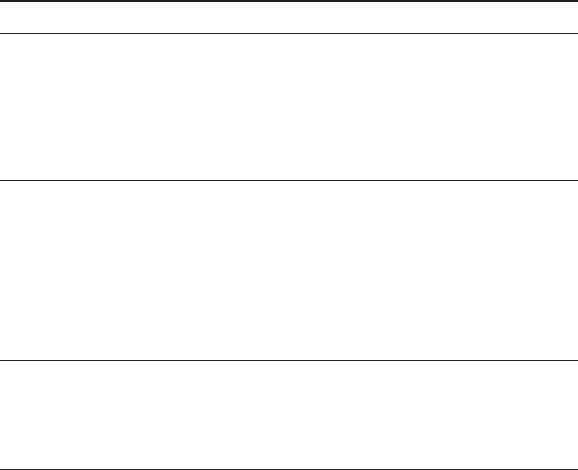
32
DE
Symptom Ursache/Abhilfe
Es werden keine
Kommunikationsziele
aufgelistet. Kein
Datenaustausch über
Bluetooth möglich.
Die
Datenübertragungs-
geschwindigkeit ist
niedrig.
Verbindung zu einer vom
Bluetooth-Zielgerät
unterstützten Funktion ist
nicht möglich.
cWenn dieses Gerät an einen Computer angeschlossen ist,
der als Slave fungiert, ist eine Kommunikation mit anderen
Geräten nicht möglich.
Beenden Sie die aktuelle Kommunikationsverbindung
(Seite 22) und stellen Sie die Verbindung von dem
Computer aus wieder her, an den dieses Gerät
angeschlossen ist.
cVergewissern Sie sich, dass der Computer mit dem
Bluetooth USB-Adapter durch nichts abgedeckt ist.
cDie Datenübertragungsgeschwindigkeit wird von Faktoren
wie dem Abstand, dem Vorhandensein von Hindernissen
zwischen den Geräten, Funkstörungen, Wänden, und der
Art der benutzen Anwendung beeinflusst. Stellen Sie den
Computer mit dem Bluetooth USB-Adapter oder das
andere Gerät an einer anderen Stelle auf.
cEs kann nur eine Verbindung zu Funktionen hergestellt
werden, die auch der Computer unterstützt, an den der
Bluetooth USB-Adapter angeschlossen ist.
Mehr dazu in der Hilfefunktion von BlueSpace NE und der
Dokumentation des jeweiligen Bluetooth-Zielgeräts.

33
DE
Bitte wenden
Symptom Ursache/Abhilfe
Eine Fehlermeldung
wird angezeigt und die
DFÜ-Verbindung über
die Bluetooth
Modemstation kommt
nicht zustande.
Dateiaustausch mit
anderen VAIO-
Computern ist nicht
möglich.
cDie vorherige Verbindung wurde möglicherweise nicht
ordnungsgemäß beendet. Starten Sie den Computer, an den
der Bluetooth USB-Adapter angeschlossen ist, neu und
stellen Sie dann erneut eine DFÜ-Verbindung her.
cDas Modem wurde möglicherweise nicht richtig installiert.
Schlagen Sie unter „Konfigurieren eines Bluetooth-Handys
bzw. -Modems“ (Seite 16) nach, wie Sie das Modem erneut
installieren können.
Wenn Sie die Neuinstallation ausgeführt haben, führen Sie
die folgenden Schritte aus.
1Starten Sie den Bluetooth USB-Adapter neu.
2Klicken Sie auf die Schaltfläche „Start“ und dann auf
„Systemsteuerung“.
Die Systemsteuerung wird angezeigt.
3Klicken Sie auf das Symbol „Netzwerk und
Internetverbindungen“.
4Klicken Sie auf das Symbol „Netswerkverbindungen“.
Das Fenster „Netswerkverbindungen“ wird angezeigt.
5Doppelklicken Sie auf das Symbol für das
Verbindungsziel.
6Klicken Sie im Fenster „Verbinden mit ...“ („...“ steht für
den Namen des Verbindungsziels) auf „Eigenschaften“ und
aktivieren Sie auf der Registerkarte „Allgemein“ das
Kontrollkästchen „Standardmodem über Bluetooth-
Verbindung (COMx)“, so dass es oben in der Liste
erscheint.
7Klicken Sie auf „OK“.
8Klicken Sie erneut auf „Wählen“, um die DFÜ-Verbindung
herzustellen.
cWenn eine alte Version die BlueSpace-Software benutzt
wird, können bei der Dateiübertragung Probleme auftreten.
Vergewissern Sie sich, dass auf dem Zielgerät die neueste
Version die BlueSpace-Software und den Bluetooth-
Gerätetreibers läuft. Informationen über die Aktualisierung
der Software finden Sie auf der VAIO-Link Website.

34
DE
Symptom Ursache/Abhilfe
Der Computer, an den
der Bluetooth USB-
Adapter angeschlossen
ist, wechselt nicht in
den Standbymodus.
Ein laufender Bluetooth-
Datenaustausch wird
unterbrochen.
Die Meldung „The
Bluetooth device requires
authentication“ erscheint
im Infobereich.
cWährend der Computer mit anderen Bluetooth-Geräten
kommuniziert, ist ein automatisches Wechseln in den
Standbymodus nicht möglich. Zum Aktivieren des
Standbymodus müssen alle Bluetooth-Kommunikationen
beendet werden.
cBeenden Sie die BlueSpace-Kommunikation, ziehen Sie
den Bluetooth USB-Adapter aus dem USB-Anschluss,
stecken Sie ihn danach wieder an den Anschluss an, und
starten Sie die Bluetooth-Kommunikation erneut.
Andere Geräte in der Nähe einer LAN-Kommunikation
können die Unterbrechung einer laufenden Bluetooth-
Kommunikation verursachen.
cDas Bluetooth-fähige Zielgerät fordert eine
Verbindungsauthentifizierung an. Für eine Bluetooth-
Kommunikation mit diesem Gerät ist eine gegenseitige
Authentifizierung erforderlich. Nähere Informationen dazu
finden Sie unter „Kommunikation über Windows XP-
Funktionen“ (Seite 15).
2
FR
Avant d’utiliser le PCGA-BA1, lisez
le contrat de licence de l’utilisateur
final du logiciel fourni avec l’appareil.
❑Les lois de copyright interdisent la
reproduction du logiciel ou de son
manuel en tout ou en partie, ainsi
que la location du logiciel, sans
l’autorisation du détenteur du
copyright.
❑Sony ne sera en aucun cas
responsable de tout dommage
financier ou perte de profits, y
compris des réclamations de tiers,
qui surviendraient suite à
l’utilisation du logiciel fourni avec
ce produit.
❑Si un problème de fonctionnement
de l’appareil survient suite à un
défaut de fabrication, Sony s’engage
à le remplacer. Toutefois, Sony
n’accepte aucune autre
responsabilité.
❑Le logiciel fourni avec cet appareil
ne peut pas être utilisé avec d’autres
appareils.
❑Veuillez noter que, suite à des
efforts continus d’amélioration de la
qualité, les spécifications du logiciel
peuvent être modifiées sans préavis.
❑Dans le cas d’une utilisation de cet
appareil avec un logiciel autre que le
logiciel fourni, l’appareil n’est pas
couvert par la garantie.
Avertissements
❑Pour prévenir tout risque de
décharge électrique, abstenez-vous
d’ouvrir le boîtier de l’appareil. Ne
confiez son entretien qu’à une
personne qualifiée.
❑Pour prévenir tout risque d’incendie
ou d’électrocution, préservez cet
appareil de la pluie et de l’humidité.
❑L’utilisation de la technologie
Bluetooth™ peut être limitée par le
propriétaire d’un immeuble ou les
responsables d’une société. Son
utilisation peut être néfaste dans un
avion, un hôpital ou un
environnement qui présente un
risque d’interférence avec d’autres
appareils ou services.
❑Si vous n’êtes pas certain des règles
en vigueur dans votre
environnement ou votre société,
nous vous invitons à solliciter une
autorisation d’utilisation de la
technologie Bluetooth™.
❑Adressez-vous à votre médecin ou
au fabricant de dispositifs médicaux
personnels (stimulateurs cardiaques,
prothèses auditives, etc.) pour
connaître les restrictions quant à
cette technologie.

3
FR
Réglementations
Pour les clients en Europe
Par la présente, Sony garantit que le
PCGA-BA1 Bluetooth™ USB
Adapter (l’adaptateur USB
Bluetooth™ PCGA-BA1) est
conforme aux principales
recommandations et autres
dispositions pertinentes de la directive
1995/5/CE.
L’accessoire PCGA-BA1 est un
dispositif radio Bluetooth™ de classe
2 utilisant une bande de fréquence de
2,4 GHz (2,400GHz – 2,4835GHz). Il
autorise des communications sans fil
avec d’autres périphériques
compatibles Bluetooth™, via plusieurs
profils : port série Bluetooth™, accès
réseau à distance via téléphone
portable ou modem, Object Push ou
Basic Imaging.
L’accessoire PCGA-BA1 est conforme
aux réglementations en vigueur dans
les pays suivants : Autriche,
Belgique, Danemark, Finlande,
France, Grèce, Allemagne, Islande,
Irlande, Italie, Luxembourg,
Norvège, Portugal, Espagne, Suède,
Suisse, Pays-Bas et Royaume-Uni.
En France, l’usage de ce produit est
exclusivement réservé à l’intérieur.
Le PCGA-BA1 Bluetooth™ USB
Adapter (l’adaptateur USB
Bluetooth™ PCGA-BA1)
est
conforme aux normes EN 55022
Classe B et EN 55024, limitant
l’emploi dans les environnements
résidentiel, professionnel et industriel
léger.
•VAIO et sont des marques
déposées de Sony Corporation.
•Microsoft et Windows sont des
marques déposées de Microsoft
Corporation aux Etats-Unis et dans
les autres pays.
•BLUETOOTH et son logo sont des
marques appartenant à Bluetooth
SIG, Inc., Etats-Unis, et sont
utilisées sous licence par Sony
Corporation.
•Les autres noms de système et de
produit mentionnés dans le présent
document sont généralement des
marques déposées ou des marques
commerciales de leurs constructeurs
bien que les symboles ™ et ® ne
soient pas utilisés.
•Dans ce manuel, Microsoft®
Windows® XP Edition Familiale
et Microsoft® Windows® XP
Professionnel sont désignés par le
terme Windows XP. FR

4
FR
Table des
matières
Introduction .......................................5
Utilisation de cet appareil..........7
Types de raccordement aux
périphériques Bluetooth......... 8
Insertion de l’adaptateur
USB Bluetooth ............................ 10
Communications à l’aide de
BlueSpace NE .............................11
Communications à l’aide des
fonctions Windows XP ...............15
Utilisation d’un
téléphone portable ou d’un
modem Bluetooth ................ 16
Attribution d’un nom d’appareil
Bluetooth à l’ordinateur/
modification du nom
d’appareil Bluetooth ............20
Pour terminer la
communication Bluetooth ...21
Précautions d’utilisation ..................22
Entretien ..........................................23
Technologie de communication sans
fil Bluetooth ................................ 24
Format de connexion ............... 24
Vitesse .....................................25
Portée et puissance de
communication ....................25
Norme Bluetooth ..................... 25
Sécurité ............................................26
Aide .................................................27
Spécifications ..................................28
Guide de dépannage ........................29

5
FR
suite
Introduction
Cet appareil est un adaptateur USB conçu pour l’utilisation avec un
ordinateur sans les fonctions Bluetooth intégrées. Il permet la
communication sans fil avec d’autres appareils compatibles Bluetooth.
z Technologie Bluetooth sans fil
La technologie Bluetooth sans fil permet une connectivité instantanée de courte portée
sans câblage encombrant. Pour plus de détails, reportez-vous à la section « Technologie
sans fil Bluetooth » en page 25.
Quels sont les modèles d’ordinateurs avec lesquels
l’adaptateur USB Bluetooth PCGA-BA1 peut être utilisé ?
Ordinateurs portables Sony VAIO utilisant Windows XP (excepté les
modèles avec les fonctions Bluetooth intégrées).
Le Service Pack 1 pour Windows XP doit être installé. Vérifiez la version
de votre système d’exploitation et mettez-le à jour si nécessaire. Pour plus
de détails, reportez-vous au document « Lisez-moi en premier ».
Remarque
Pour plus d’informations sur les ordinateurs VAIO compatibles Bluetooth, reportez-vous
à la section « Aide » (page 28).
Caractéristiques
•La compatibilité Bluetooth permet la communication sans fil dans une
plage de 10 mètres (la plage de communication varie en fonction du type
de logiciel utilisé, des obstacles séparant les appareils (murs ou autres),
du matériau utilisé pour la construction des murs, de la présence
d’interférences au niveau de la fréquence radio ainsi que d’autres
conditions environnementales).
•Les fonctions de sécurité permettent d’éviter la communication entre les
appareils Bluetooth non identifiés. Pour les détails, reportez-vous à la
section « Sécurité » en page 27.
6
FR
Quels sont les appareils Bluetooth avec lesquels l’adaptateur
USB Bluetooth PCGA-BA1 peut communiquer ?
(A compter de Mai 2003)
•Ordinateurs portables Sony VAIO avec les fonctions Bluetooth intégrées
(Pour l’Europe)
• D’autres ordinateurs portables Sony VAIO fonctionnant sous Windows
XP avec un adaptateur USB Bluetooth PCGA-BA1 installé
•D’autres appareils Sony avec la fonction Bluetooth
Vérifiez les services Bluetooth compatibles avec votre appareil Bluetooth.
z Conseil
Le CD-ROM du logiciel contient un exemplaire de ce manuel et le document « Lisez-moi en
premier » sous forme de fichiers PDF dans le répertoire « manual ».
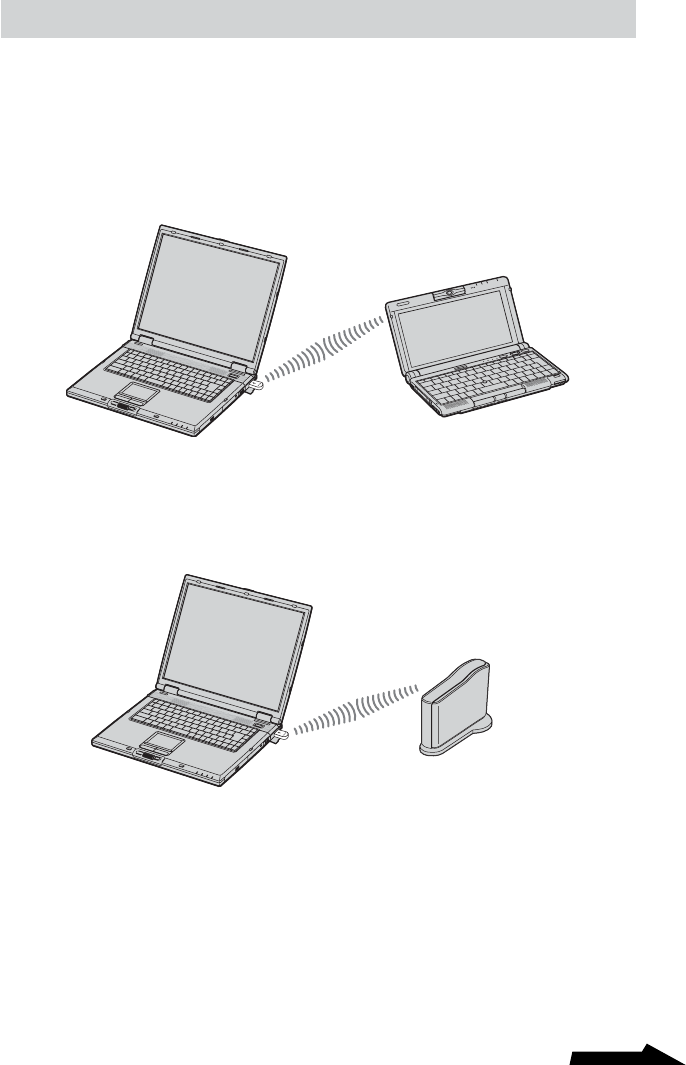
7
FR
suite
Utilisation de cet appareil
Lorsque l’adaptateur USB Bluetooth est inséré dans un ordinateur, il peut
échanger des données avec d’autres ordinateurs compatibles Bluetooth, des
téléphones mobiles, des modems, etc., à condition d’être placé à proximité
de l’autre appareil, sans aucun câblage physique.
Exemple d’utilisation (communication avec un autre ordinateur)
Exemples d’utilisation de cet appareil avec des appareils
Bluetooth tels qu’une station modem Bluetooth
Les communications Bluetooth via l’adaptateur USB Bluetooth utilisent le
logiciel BlueSpace NE fourni ou les fonctions Windows XP, selon le type
d’opération.
Ordinateur équipé d’un
adaptateur USB Bluetooth
Echange de données, etc.
Autre ordinateur
compatible Bluetooth
Ordinateur équipé d’un
adaptateur USB Bluetooth
Synchronisation de données,
échange de données, accès
automatique, etc.
Appareil compatible Bluetooth
(Station modem Bluetooth :
Europe uniquement)

8
FR
Types de raccordement aux périphériques Bluetooth
Lorsque vous vous raccordez à un périphérique Bluetooth, utilisez l'une des
méthodes suivantes (selon la fonction du périphérique).
•Logiciel BlueSpace NE
•Fonctions Windows XP (« Liaison sans fil » dans « Panneau de
configuration »)
Ce que vous pouvez faire à l'aide du logiciel BlueSpace NE
•Echanger des fichiers et des images entre ordinateurs
•Synchroniser des données et échanger des fichiers et des images avec un
PDA
•Utiliser un caméscope ou un appareil photos numérique comme caméra
distante pour échanger des images
•Envoyer des images à une caméra ou à un périphérique Bluetooth
compatible BIP (Basic Image Profile)
•Configurer le modem Bluetooth (Europe uniquement)
•Echanger des adresses avec des téléphones portables
Ce que vous pouvez faire à l'aide de Windows XP
•Accéder à Internet à l’aide d’un modem Bluetooth (Europe uniquement)
•Accéder à Internet à l’aide d’un téléphone portable
•Utiliser une souris ou un clavier
•Imprimer sur une imprimante Bluetooth
Pour pouvoir utiliser l’adaptateur USB Bluetooth, vous devez installer le
pilote du périphérique Bluetooth ainsi que le logiciel BlueSpace contenus
dans le CD-ROM fourni. Pour les instructions sur l’installation du logiciel,
reportez-vous à la brochure « Lisez-moi en premier ».

9
FR
Remarques
•Certains appareils compatibles Bluetooth risquent de ne pas fonctionner avec
l’adaptateur USB Bluetooth, en fonction de leur type, de la version du logiciel et
d’autres facteurs. Avant d’acheter un appareil compatible Bluetooth, vérifiez ses
conditions de fonctionnement.
Pour des informations sur les appareils compatibles Bluetooth, reportez-vous à la
section « Aide » (page 28).
•Il se peut que vous ne puissiez pas établir de connexion avec un ordinateur doté d’une
version de BlueSpace antérieure à 2.1.1. Pour remédier à cela, vous devez migrer vers
la version la plus récente.
Les modèles ci-dessous présentent également les limitations suivantes.
Pour pouvoir vous connecter à l’aide de BlueSpace NE avec PCG-SR31K et
PCG-C1VFK, vous devez passer à la version Windows XP, puis mettre à jour les
pilotes BlueSpace et Bluetooth.
Pour plus de détails à propos des mises à jour, reportez-vous à la section « Aide » (Page
28).
•BlueSpace NE ne prend pas en charge les connexions IP ou les fonctions « chat ». Il
n’est donc pas possible de les utiliser avec des appareils équipés de versions antérieures
de BlueSpace.
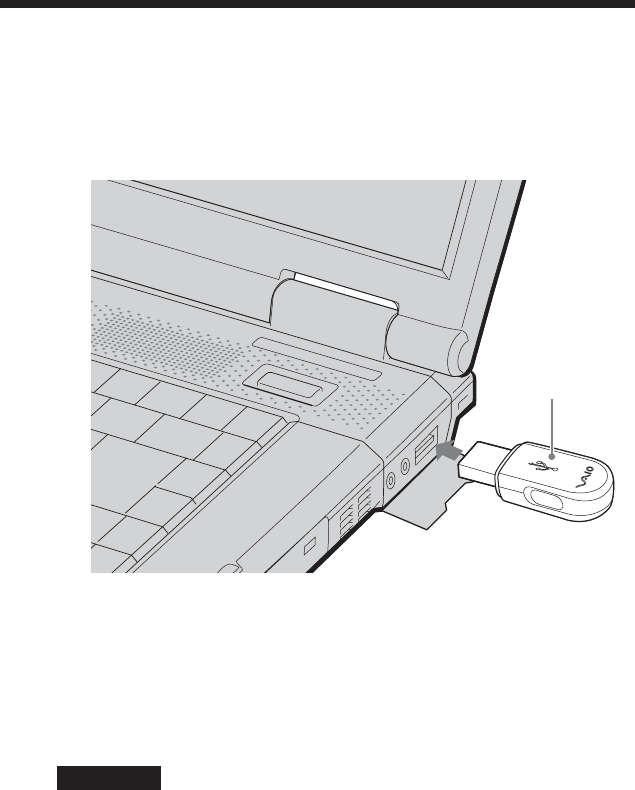
10
FR
Insertion de l’adaptateur USB
Bluetooth
Insérez l’adaptateur USB Bluetooth dans le port USB de l’ordinateur.
z Conseil
L’emplacement du port USB varie selon le modèle de l’ordinateur. Pour les détails,
reportez-vous au manuel fourni avec l’ordinateur.
Lorsque l’adaptateur USB Bluetooth est inséré dans le port USB de votre
ordinateur, il est actif dès que l’ordinateur est mis sous tension.
L’indicateur bleu de l’adaptateur s’allume pour montrer qu’il est actif.
Remarques
•Dans un avion ou tout autre endroit où les émissions radio risquent de causer un
problème, retirez l’adaptateur USB Bluetooth de l’ordinateur. Le simple arrêt du
logiciel n’est pas suffisant pour arrêter les émissions des ondes radio de l’appareil.
•Vous ne pouvez utiliser qu’un seul adaptateur USB Bluetooth par ordinateur.
•N’insérez pas l’adaptateur USB Bluetooth dans un jack USB externe. Les performances
radio ainsi que celles du logiciel ne seront pas assurées.
Insérez l’appareil
avec le
logo « VAIO »
tourné vers le haut.

11
FR
suite
Communications à l’aide de
BlueSpace NE
Cette section décrit la procédure générale de communication avec un autre
appareil compatible Bluetooth.
Avant que l’adaptateur USB Bluetooth puisse être utilisé, le pilote du
périphérique Bluetooth et le logiciel BlueSpace contenus dans le CD-ROM
fourni doivent être installés. Pour les instructions sur l’installation du
logiciel, reportez-vous à la brochure « Lisez-moi en premier ».
Remarques
•Certains appareils compatibles Bluetooth risquent de ne pas fonctionner avec
l’adaptateur USB Bluetooth, en fonction de leur type, de la version du logiciel et
d’autres facteurs. Avant d’acheter un appareil compatible Bluetooth, vérifiez ses
conditions de fonctionnement.
Pour des informations sur les appareils compatibles Bluetooth, reportez-vous à la
section « Aide » (page 28).
•Il se peut que vous ne puissiez pas établir de connexion avec un ordinateur doté d’une
version de BlueSpace antérieure à 2.1.1. Pour remédier à cela, vous devez migrer vers
la version la plus récente.
Les modèles ci-dessous présentent également les limitations suivantes.
Pour pouvoir vous connecter à l'aide de BlueSpace NE avec PCG-SR31K et PCG-
C1VFK, vous devez passer à la version Windows XP, puis mettre à jour les pilotes
BlueSpace et Bluetooth.
•BlueSpace NE ne prend pas en charge les connexions IP ou les fonctions « chat ». Il
n’est donc pas possible de les utiliser avec des appareils équipés de versions antérieures
de BlueSpace.
• Il est possible que certains périphériques compatibles Bluetooth aient un
fonctionnement différent de celui décrit dans les procédures suivantes. Reportez-vous
au manuel fourni avec le périphérique Bluetooth ou aux informations sur les produits
Bluetooth de Sony à l'adresse
Pour les clients aux Etats-Unis et au Canada
http://www.ita.sel.sony.com/support/bluetooth/
Pour les clients en Europe
www.vaio-link.com
Pour les clients dans d'fautres régions
http://www.css.ap.sony.com/
Reportez-vous à la section « Types de raccordement aux périphériques Bluetooth »
pour connaître les types de communications pour lesquels vous pouvez utiliser
BlueSpace NE. (Page 8)
Reportez-vous également à l'Aide en ligne de BlueSpace NE.
•Ne couvrez pas l’adaptateur USB Bluetooth en cours d’utilisation. Des interférences
pourraient se produire au niveau des communications.
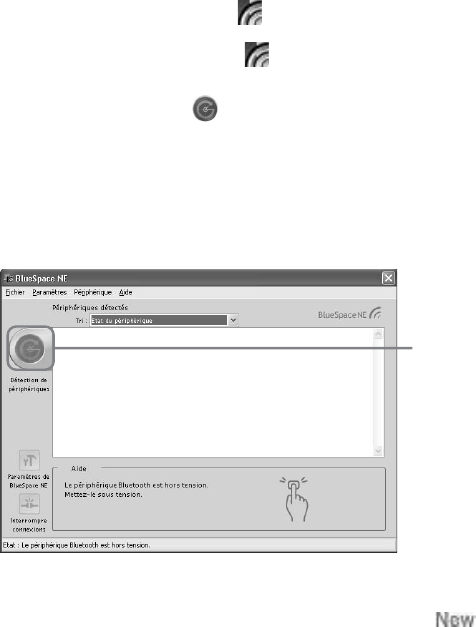
12
FR
•Si le LAN sans fil et les fonctions Bluetooth sont utilisés en même temps avec le même
ordinateur, la vitesse de communication risque d’être réduite à cause des interférences
électromagnétiques ou d’autres effets peuvent se produire.
• Si un mode d’économie d’énergie est activé dans l’un des ordinateurs, la
communication Bluetooth peut ne pas être possible. Réglez les deux ordinateurs sur le
mode normal.
1Mettez l’ordinateur sous tension et insérez l’adaptateur USB
Bluetooth dans le port USB (page 10).
2Cliquez sur le bouton « démarrer », puis sélectionnez
«Tous les programmes » – « BlueSpace NE » –
«BlueSpace NE ».
BlueSpace NE démarre et sa fenêtre principale apparaît.
z Conseil
Lorsque la fenêtre « Bienvenue dans BlueSpace NE » apparaît, cliquez sur OK.
Avec les réglages par défaut activés, apparaît automatiquement dans la zone de
notification au prochain démarrage de Windows. Dans ce cas, vous pouvez lancer
BlueSpace NE en double-cliquant sur .
3Cliquez sur la touche (Détection de périphériques) dans
la fenêtre principale.
L’ordinateur doté de l’adaptateur USB Bluetooth commence à
rechercher les autres appareils compatibles Bluetooth situés à
proximité. Une fois cette recherche terminée, tous les appareils
Bluetooth détectés apparaissent dans la liste.
z Conseil
Lorsqu’un périphérique est détecté pour la première fois, la marque apparaît
dans la liste des périphériques de la fenêtre principale.
Cliquez ici
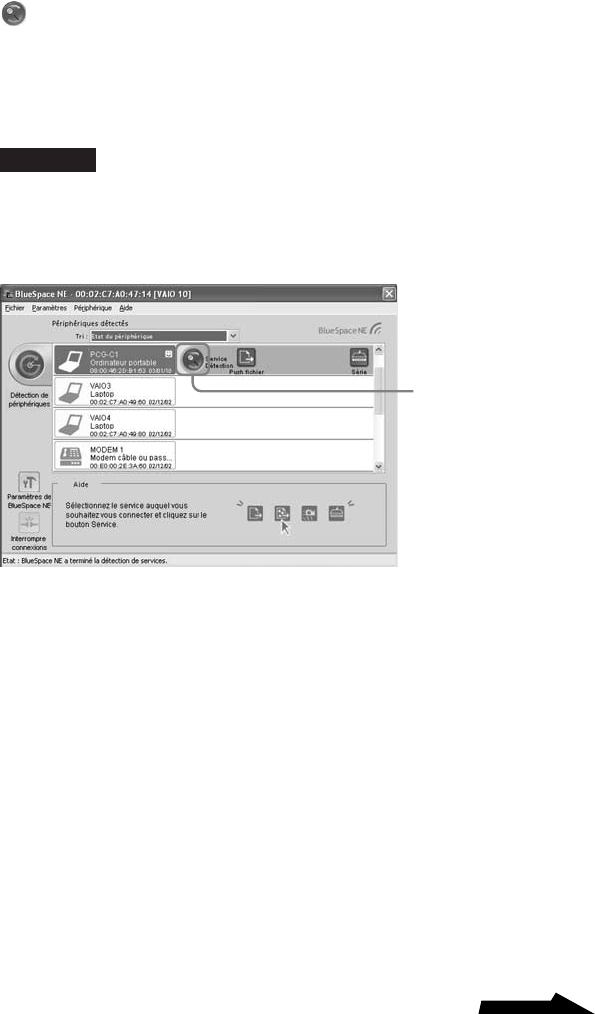
13
FR
suite
4Dans la liste des périphériques, sélectionnez celui auquel
vous souhaitez vous connecter, puis cliquez sur la touche
(Détection de services).
L’ordinateur recherche les services sur le périphérique sélectionné et
lorsqu’il a terminé, il affiche les icônes correspondant aux services
disponibles (les services pris en charge par le périphérique et
BlueSpace NE).
Remarque
Si l’authentification entre les périphériques n’est pas terminée, une fenêtre peut
apparaître pour vous demander de confirmer si vous souhaitez effectuer uniquement
une détection des services ou bien une détection et une authentification. Suivez les
instructions à l’écran pour échanger les clés de passe et terminer l’authentification.
z Qu’est-ce qu’une clé de passe ?
Une clé de passe est un code secret saisi par l’utilisateur pour permettre
la communication entre deux appareils compatibles Bluetooth. Lorsque
la même suite de caractères alphanumériques est saisie dans les deux
appareils, la communication est possible. La clé de passe peut être
modifiée pour chaque session de communication. Une fois qu’un lien
valable est établi, la communication est possible pendant une période
prédéterminée sans avoir à entrer de nouveau la clé de passe.
5Sélectionnez et connectez-vous au service que vous
souhaitez utiliser.
Cliquez ici

14
FR
Si la bulle « Un périphérique Bluetooth nécessite une
authentification » apparaît dans la zone de notification
Le périphérique compatible Bluetooth cible a besoin d’une authentification
de la connexion. Dans ce cas, une authentification mutuelle est nécessaire
pour autoriser les communications Bluetooth avec ce périphérique.
Pour authentifier la communication, cliquez sur dans la zone de
notification. Lorsque la fenêtre « Assistant Connexion Bluetooth » apparaît,
suivez les instructions qui s’affichent pour échanger les clés de passe.
Pour sauter cette étape, cliquez sur dans la bulle ou sur « Annuler »
dans la fenêtre « Assistant Connexion Bluetooth ».

15
FR
suite
Communications à l’aide des
fonctions Windows XP
Pour connaître les types de communication utilisant les fonctions Windows
XP, reportez-vous à la section « Types de reccordement aux périphériques
Bluetooth » (Page 8).
Pour communiquer à l’aide des fonctions Windows XP, reportez-vous à
l’Aide Liaison sans fil de Windows XP et au manuel fourni avec le
périphérique compatible Bluetooth.
z Conseil
Avant de procéder pour la première fois à une connexion commutée avec le téléphone
portable ou le modem Bluetooth, vous devez installer le périphérique conformément à la
liaison sans fil, puis établir la connexion commutée. Pour plus de détails, reportez-vous à
l’Aide Liaison sans fil de Windows XP.
Pour afficher l'aide de la liaison sans fil Windows XP.
1Cliquez sur « démarrer », puis sur « Panneau de configuration ».
2Cliquez sur l’icône « Imprimantes et autres périphériques ».
3Cliquez sur l’icône « Liaison sans fil ».
4Double-cliquez sur l’onglet « Bluetooth », puis sur « Afficher les
détails Bluetooth ».
Si la bulle « Un périphérique Bluetooth nécessite une
authentification » apparaît dans la zone de notification
Le périphérique compatible Bluetooth cible a besoin d’une authentification
de la connexion. Dans ce cas, une authentification mutuelle est nécessaire
pour autoriser les communications Bluetooth avec ce périphérique.
Pour authentifier la communication, cliquez sur dans la zone de
notification. Lorsque la fenêtre « Assistant Connexion Bluetooth » apparaît,
suivez les instructions qui s’affichent pour échanger les clés de passe.
Pour sauter cette étape, cliquez sur dans la bulle ou sur « Annuler »
dans la fenêtre « Assistant Connexion Bluetooth ».

16
FR
Utilisation d’un téléphone portable ou d’un modem
Bluetooth
Si vous utilisez les fonctions Windows XP pour connecter l’adaptateur
USB Bluetooth à un téléphone portable ou à un modem Bluetooth, vous
pouvez établir une communication commutée sans câble de connexion.
Cette section décrit l’installation d’un téléphone portable ou d’un modem
Bluetooth, ainsi que la configuration de la connexion commutée. Pour plus
d’informations, reportez-vous au manuel fourni avec le téléphone portable
Bluetooth et à l’Aide Liaison sans fil de Windows XP.
Configuration d’un téléphone portable ou d’un modem
Bluetooth
1Mettez le téléphone portable ou le modem Bluetooth sous
tension et réglez-le pour permettre la détection.
Pour plus de détails, reportez-vous aux manuels fournis avec le
téléphone portable ou le modem Bluetooth.
2Mettez l’ordinateur sous tension et insérez l’adaptateur USB
Bluetooth dans le port USB.
3Cliquez sur « démarrer », puis sélectionnez « Panneau de
configuration ».
Le panneau de configuration apparaît.
4Cliquez sur l’icône « Imprimantes et autres périphériques ».
5Cliquez sur « Lianson sans fil », puis sur l’onglet
« Bluetooth ».
6Cliquez sur « Ajouter », puis sur « Suivant » dans la fenêtre
«Assistant Connexion Bluetooth ».
La détection de services commence et le téléphone portable Bluetooth
est détecté.

17
FR
suite
7Cliquez sur l’icône « Téléphone cellulaire », puis sur
« Suivant ».
Le message «Authentifier ce périphérique? » apparaît.
Reportez-vous au manuel fourni avec le téléphone portable pour
déterminer si l’authentification du périphérique est nécessaire.
Si tel est le cas, procédez comme suit.
8Sélectionnez « Oui. Ce périphérique doit être authentifiiê
avant utilisation. », puis cliquez sur « Suivant ».
Le message « Entrez une clé d'accés pour le périphérique Bluetooth. »
apparaît.
9Si nécessaire, saisissez la clé de passe dans la colonne
prévue à cet effet, puis cliquez sur « Suivant ».
Remarque
Il est possible qu’une clé de passe soit déjà affichée dans l’assistant de connexion
Bluetooth, mais selon le téléphone portable, seule une certaine clé de passe peut être
acceptée. Suivez les instructions du manuel de votre téléphone portable pour saisir la
clé de passe.
10
Si nécessaire, saisissez la clé de passe entrée avec
l’assistant de connexion.
Le message « Prière de spécifier le service à activer entre l'appareil et
Windows » apparaît.
Remarque
Selon votre téléphone portable Bluetooth, la saisie de la clé de passe n’est peut-être
pas nécessaire.
11
Sélectionnez « Accé à distance », puis cliquez sur
« Suivant ».
La fenêtre « Assistant Connexion Bluetooth » apparaît.
12
Cliquez sur « Terminer ».
L’icône du téléphone cellulaire apparaît pour signaler une liaison sans
fil lorsque la procédure d’authentification est terminée. L’installation
du téléphone portable ou du modem Bluetooth est terminée.

18
FR
Préparatifs pour réaliser une connexion commutée
1Mettez le téléphone portable ou le modem Bluetooth sous
tension et réglez-le pour permettre la détection.
Pour plus de détails, reportez-vous aux manuels fournis avec le
téléphone portable ou le modem Bluetooth.
2Mettez l’ordinateur sous tension et insérez l’adaptateur USB
Bluetooth dans le port USB.
3Cliquez sur le bouton « démarrer », puis sur « Panneau de
configuration ».
4Cliquez sur l’icône « Connexions réseau et Internet ».
5Cliquez sur l’icône « Connexion réseau ».
La fenêtre « Connexion réseau » apparaît.
6Cliquez sur « Créer une nouvelle connexion ».
La fenêtre « Bienvenue dans I’Assistant Nouvelle connexion »
apparaît.
7Cliquez sur « Suivant », vérifiez que « Établir une connexion
à Internet » est sélectionné et cliquez sur « Suivant ».
Si l’option n’est pas cochée, cliquez sur pour qu’elle devienne .
Lorsque vous cliquez sur « Suivant », la fenêtre « En cours de
préparation » apparaît.
8Cochez l’option « Configurer ma connexion manuellement ».
Cliquez, ensuite, sur « Suivant ».
La fenêtre « Connexion Internet » apparaît.
9Vérifiez que « Se connecter en utilisant un modem d’accès à
distance » est cochée et cliquez sur « Suivant ».
Si l’option n’est pas cochée, cliquez sur pour qu’elle devienne .

19
FR
suite
10
Cliquez dans la case à cocher « Modem standard sur liaison
Bluetooth (COMx) ».
Si un autre modem est sélectionné, cliquez dans la case à cocher pour
le décocher.
11
Cliquez sur « Suivant ».
La fenêtre « Nom de la connexion » apparaît.
12
Saisissez le nom à utiliser pour cette connexion dans le
champ « Nom du fournisseur de services Internet », puis
cliquez sur « Suivant ».
La fenêtre « Entrez le numéro de téléphone à composer » apparaît.
13
Entrez le numéro de téléphone du point d’accès fournisseur
de services Internet et cliquez sur « Suivant ».
La fenêtre « Information de compte Internet » apparaît.
14
Configurez « Nom d’utilisateur », « Mot de passe » et
« Confirmer le mot de passe » et cliquez sur « Suivant ».
La fenêtre « Fin de l’Assistant Nouvelle connexion » apparaît.
15
Cliquez sur « Terminer ».
Etablissement d’une connexion commutée
1Cliquez sur « démarrer », puis sur « Panneau de
configuration » – « Connexions réseau et Internet » –
«Connexion réseau ».
La fenêtre « Connexion réseau » apparaît.
2Double-cliquez sur l’icône de destination de la connexion
créée au cours de la procédure « Créer une nouvelle
connexion ».
3Cliquez sur « Numéroter ».
La connexion commutée est établie via la connexion Bluetooth.

20
FR
Pour terminer la connexion automatique
Cliquez à droite sur * dans la barre des tâches et sélectionnez
« Deconnecter » dans le menu.
*L’icône qui apparaît dans la barre des tâches ressemble exactement à celle de l’appareil
réseau sans fil connecté. Vous pouvez vérifier le nom de l’appareil connecté en
déplaçant le pointeur sur l’icône dans la barre des tâches.
Pour les informations sur comment terminer la communication Bluetooth,
reportez-vous à « Pour terminer la communication Bluetooth » (page 21).
Attribution d’un nom d’appareil Bluetooth à
l’ordinateur/modification du nom d’appareil Bluetooth
Le nom de l’ordinateur à afficher lorsque celui-ci est détecté par un autre
périphérique Bluetooth peut être défini à l’aide des fonctions Windows XP.
1Mettez l’ordinateur sous tension et insérez l’adaptateur USB
Bluetooth dans le port USB (page 10).
2Cliquez sur « démarrer », puis sur « Panneau de
configuration ».
Le panneau de configuration apparaît.
3Cliquez sur l’icône « Imprimantes et autres périphériques ».
4Cliquez sur l’icône « Liaison sans fil ».
5Cliquez sur l’onglet « Matériel ».
6Sélectionnez « Sony Bluetooth USB Adapter », puis cliquez
sur « Propriétés ».
La fenêtre « Propriétés de Sony Bluetooth USB Adapter » apparaît.
7Cliquez sur l’onglet « Détails ».
8Modifiez le nom, puis cliquez sur OK.
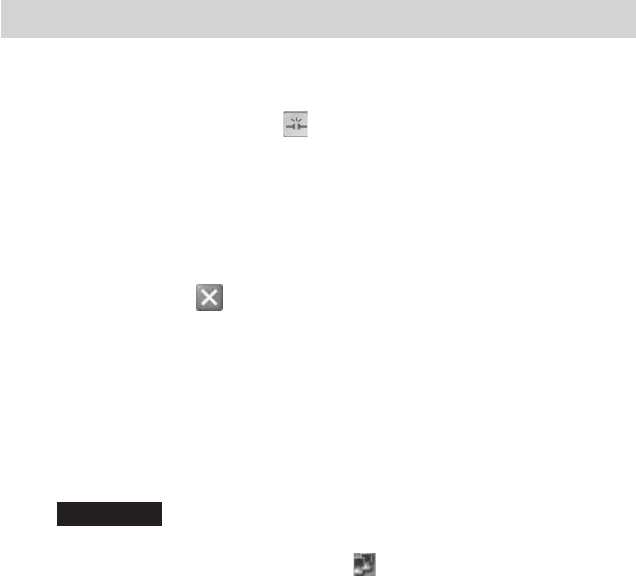
21
FR
Pour terminer la communication Bluetooth
Lors d’une communication à l’aide de BlueSpace NE
1Cliquez sur la touche du service connecté dans la fenêtre
BlueSpace NE.
Une fenêtre de confirmation apparaît.
2Cliquez sur « Oui ».
3Cliquez sur dans le coin supérieur droit de la fenêtre
pour fermer la fenêtre BlueSpace NE.
4Retirez l’adaptateur USB Bluetooth du port USB.
Lors d’une communication à l’aide des fonctions Windows XP.
Retirez l’adaptateur USB Bluetooth du port USB.
Remarques
• Tandis que l’ordinateur est connecté au téléphone portable ou au modem Bluetooth,
cliquez avec le bouton droit de la souris sur * dans la barre des tâches et
sélectionnez « Déconnecter » dans le menu pour d’abord mettre fin à la connexion
commutée. Effectuez, ensuite, les étapes suivantes pour terminer la communication
Bluetooth.
*L’icône qui apparaît dans la barre des tâches ressemble exactement à celle de
l’appareil réseau sans fil connecté. Vous pouvez vérifier le nom de l’appareil
connecté en déplaçant le pointeur sur l’icône dans la barre des tâches.
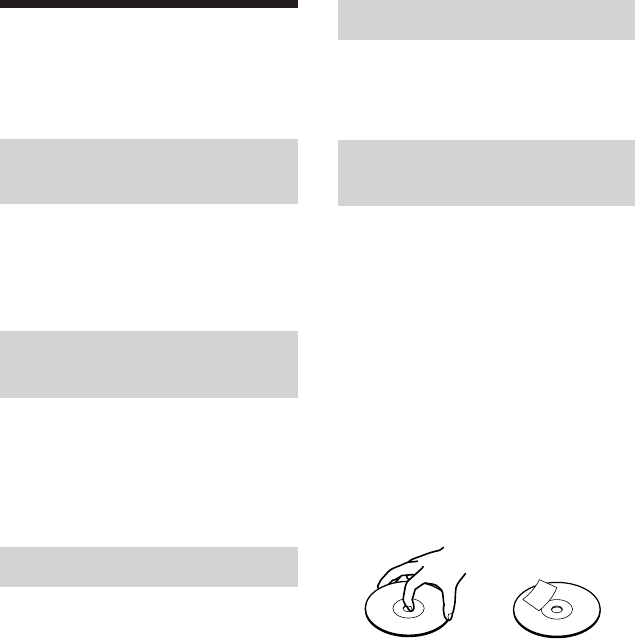
22
FR
Précautions
d’utilisation
Protéger l’appareil des
chocs
Pour prévenir les risques de
dommages, ne soumettez pas
l’appareil à des chocs violents et ne le
laissez pas tomber.
Emplacement pendant
l’utilisation et entreposage
Ne pas utiliser ni entreposer cet
appareil dans des endroits soumis à
une forte humidité, à des températures
élevées, au rayonnement direct du
soleil ou à une forte poussière.
Fonctionnement
•Ne pas poser d’objets lourds sur
l’appareil.
•Protéger l’appareil des changements
soudains de température. Ne pas
utiliser l’appareil immédiatement
après l’avoir déplacé d’un
environnement froid à un
environnement chaud, ou si la
température ambiante a augmenté
très soudainement. De la
condensation pourrait alors se
produire à l’intérieur de l’appareil.
Si la température ambiante a changé
de façon importante pendant le
fonctionnement, mettez l’appareil
hors tension et laissez-le reposer
pendant une heure environ.
Transport
Conservez l’emballage de l’appareil
réutilisez-les lors du transport de
l’appareil.
Remarques sur les
disques
Manipulation des disques
•Pour que les disques restent propres,
les tenir par la partie périphérique.
Ne jamais en toucher la surface.
•Ne pas coller de papier ou
d’étiquette et ne pas écrire sur la
surface du disque.
•Ne pas utiliser un disque si celui-ci
comporte du ruban adhésif ou des
traces de colle. Un tel disque pourrait
endommager le lecteur.
Précautions
•Ne pas exposer le disque au
rayonnement direct du soleil ou à
des sources de chaleur telles que des
conduits de chauffage et ne pas le
laisser dans une voiture garée en
plein soleil.
•Après utilisation, ranger le disque
dans son boîtier. Laisser un disque
hors de son boîtier ou l’empiler avec
d’autres disques hors de leurs
boîtiers peut endommager le disque.
Entretien
•Les traces de doigts, la poussière et
la saleté peuvent causer des erreurs
IncorrectCorrect
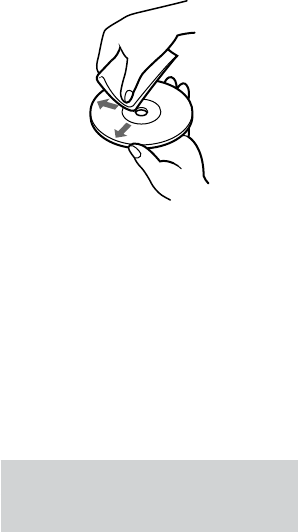
23
FR
de lecture ou une diminution de la
qualité sonore. Assurez-vous que les
disques soient toujours propres.
•Nettoyer le disque à l’aide d’un
chiffon conçu à cet effet. Essuyer le
disque en allant du centre vers
l’extérieur.
•Si le disque est souillé, le nettoyer
avec un chiffon doux humide, puis
l’essuyer avec un chiffon doux et
sec.
•Ne pas utiliser de solvants tels que
la benzine, des diluants ou des
nettoyants ordinaires ou encore des
antistatiques en aérosol destinés aux
disques en vinyle.
Technologie de
communication Bluetooth
•La bande 2,4 GHz utilisée par la
technologie Bluetooth et les
appareils LAN sans fil est également
utilisée par divers autres appareils.
Les appareils compatibles Bluetooth
utilisent une technologie qui
minimise les interférences avec
d’autres appareils fonctionnant sur
la même fréquence. Cependant, le
débit de communication et la portée
de transmission peuvent être réduits.
Les interférences avec d’autres
appareils peuvent également
entraîner l’arrêt total des
communications.
•Le débit de transfert des données
varie en fonction de la distance et
des obstacles séparant les appareils,
de la configuration des appareils,
des interférences radio, du système
d’exploitation, de l'application
logicielle, etc.
•La plage de communication varie en
fonction du type de logiciel utilisé,
des obstacles séparant les appareils
(murs ou autres), du matériau utilisé
pour la construction des murs, de la
présence d’interférences au niveau
de la fréquence radio ainsi que
d’autres conditions
environnementales.
•Si le LAN sans fil et les fonctions
Bluetooth sont utilisés en même
temps avec le même ordinateur, la
vitesse de communication risque
d’être réduite à cause des
interférences électromagnétiques ou
d’autres effets peuvent se produire.
•Prière de noter qu'en raison des
limitations de la norme Bluetooth,
de grands fichiers risquent
occasionnellement d'être corrompus
pendant le transfert continu à cause
des interférences électromagnétiques
provenant de l'environnement.

24
FR
Entretien
Nettoyage du boîtier
•Essuyer l’extérieur de l’appareil
avec un chiffon doux et sec. Pour
enlever les taches, humectez le
chiffon avec une solution détergente
neutre et non corrosive. N’utilisez
pas de diluants, d’alcool, de benzine
ou tout autre produit qui pourrait
endommager la surface de
l’appareil.
• Eliminez les traces de doigt en les
essuyant avec un chiffon à lentilles.
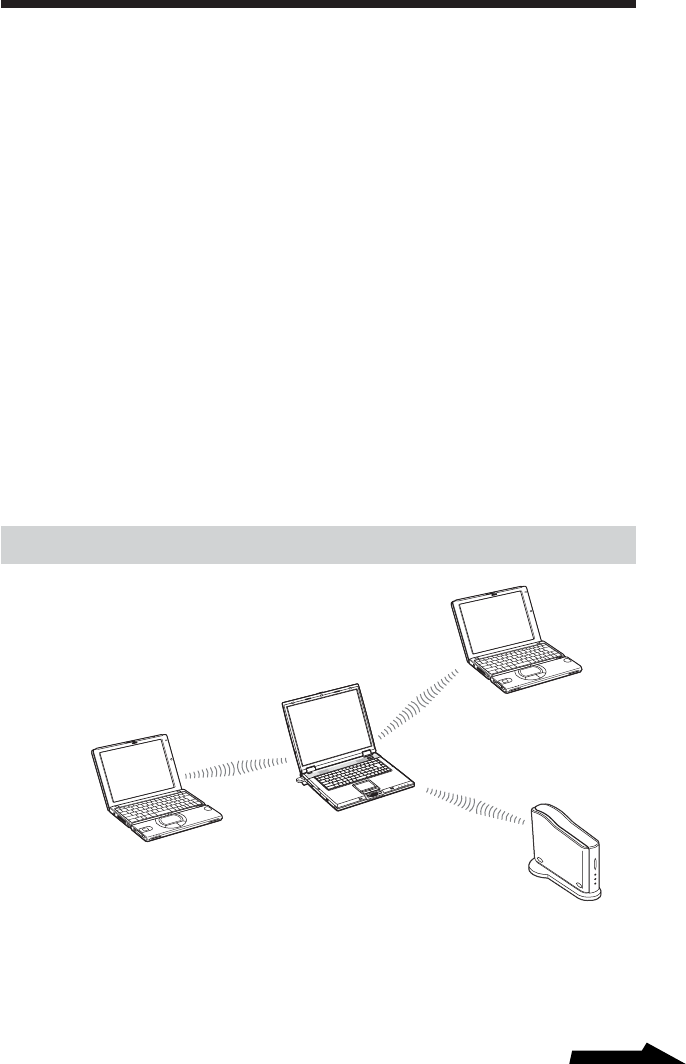
25
FR
suite
Technologie de communication sans
fil Bluetooth
La technologie de communication sans fil Bluetooth est une innovation qui
s’apprête à révolutionner le domaine du réseautage personnel. La
compatibilité Bluetooth, en tant que norme internationale pour la
communication sans fil de courte portée à faible coût, sera bientôt intégrée
à une vaste gamme d’appareils. Cette fonctionnalité permet aux ordinateurs
portables, aux téléphones portables et à d’autres dispositifs mobiles de
communiquer entre eux et d’accéder à Internet.
Le groupe Bluetooth SIG (Special Interest Group) rassemble des fabricants
d’appareils électroniques et de communication et d’autres sociétés
d’avant-garde dans le domaine de l’informatique et du réseau. Bluetooth
SIG a mis au point les normes techniques des communications Bluetooth.
Plusieurs appareils compatibles Bluetooth sont actuellement en
développement et en lancement. En plus de Sony, Bluetooth SIG compte
plus de deux mille sociétés dans le monde, y compris plusieurs grands
fabricants d’ordinateurs et d’équipement de communication, ainsi que des
fabricants d’électroménagers.
Format de connexion
A l'aide de Bluetooth, l'ordinateur portable dans lequel il est installé peut
communiquer sans fil avec des périphériques proches (sans câbles de
connexion.).
De plus, les fichiers peuvent être échangés sans fil entre l'ordinateur
portable dans lequel cet appareil est installé et d'autres ordinateurs activés
Bluetooth ou des appareils photos numériques.

26
FR
Pour établir une connexion sans fil entre l'ordinateur portable dans lequel
cet appareil est installé et un autre appareil activé Bluetooth, chacun des
deux appareils doit accepter un set commun de fonctions (profil).
Vitesse
Les communications Bluetooth permettent un débit de transfert de données
maximal de 723 Kbps, mais le débit de transfert de données réel varie selon
divers facteurs, par exemple la distance ou les obstacles présents entre les
appareils, les interférences radio, le système d’exploitation ou le logiciel
utilisés, ainsi que selon la sensibilité de l’équipement et le rendement de
l’antenne. Le débit de transfert de données est optimisé pour offrir le
meilleur débit possible selon un ensemble de conditions préétablies.
Portée et puissance de communication
Les appareils compatibles Bluetooth sont divisés en plusieurs catégories.
Les appareils Power Class 1 peuvent communiquer dans une plage allant de
10 à 100 mètres*. Les appareils Power Class 2 ou 3 peuvent communiquer
dans une plage de 10 mètres*. L’adaptateur USB Bluetooth est un appareil
Power Class 2.
*En considérant qu’aucun obstacle n’est présent.
La plage de communication varie en fonction du type de logiciel utilisé, des obstacles
séparant les appareils (murs ou autres), du matériau utilisé pour la construction des
murs, de la présence d’interférences au niveau de la fréquence radio ainsi que d'autres
conditions environnementales.
Norme Bluetooth
Dans le but de faciliter la communication entre les appareils compatibles
Bluetooth de différents fabricants, Bluetooth SIG a mis au point un
ensemble de normes portant entre autres sur le système de transfert de
données sans fil, le mode d’application des mesures de sécurité et les
formats de données spécifiques à divers logiciels. Tous les appareils
compatibles Bluetooth doivent être soumis à une procédure d’homologation
approuvée par Bluetooth SIG, qui certifie leur conformité aux exigences
applicables.
Toutefois, même lorsque les exigences d’homologation sont satisfaites, la
performance et les spécifications des appareils individuels ainsi que leur
procédure de fonctionnement varient, et l’échange de données n’est pas
toujours possible.

27
FR
Sécurité
La technologie de communication sans fil Bluetooth met en oeuvre une
fonction d’authentification qui peut être utilisée pour prévenir l’accès
clandestin par des appareils compatibles Bluetooth non désignés pour la
communication. La première fois que deux appareils compatibles Bluetooth
communiquent, une clé de passe doit être saisie avant que les appareils
puissent faire l’échange de données. Une fois la connexion établie, la
communication entre les appareils peut s’effectuer à intervalles réguliers
prédéfinis (réglage par défaut dans le logiciel BlueSpace : Indéfini) sans
avoir à resaisir la clé de passe.
L’adaptateur USB Bluetooth peut être réglé pour ne pas être découvert par
d’autres appareils Bluetooth. Pour les informations sur le réglage de Durée
de sauvegarde des données et le contrôle de la réponse de détection
d’appareil, reportez-vous à la fonction d’aide du logiciel BlueSpace.

28
FR
Aide
Cette section décrit les moyens
d’assistance et de service offerts par
Sony, ainsi que des conseils de
dépannage pour votre station modem
Bluetooth.
A propos des options
d’assistance Sony
Sony offre les options d’assistance
suivantes pour votre adaptateur USB
Bluetooth. Si vous avez des questions
au sujet de la station modem Bluetooth
et du logiciel, adressez-vous aux
endroits suivants :
❑Le fichier Lisez-moi en premier
explique comment installer le
logiciel avant d’utiliser l’adaptateur
USB Bluetooth.
❑Ce guide explique le
fonctionnement de la station modem
Bluetooth.
Pour les clients aux Etats-
Unis et au Canada
❑En composant le numéro du Centre
des services d’information
client Sony, vous obtiendrez des
informations sur votre ordinateur
bloc-notes et d’autres produits Sony
qui fonctionnent avec votre
ordinateur. Pour consulter le Centre
des services d’information client
Sony, composez le
1-888-4SONYPC (1-888-476-6972).
❑Le service fax de Sony fournit
des réponses aux questions les plus
fréquemment posées. Vous pouvez
utiliser ce service automatisé pour
demander une liste des thèmes
abordés et sélectionner ceux que
vous voulez recevoir. Pour consulter
le service fax de Sony, formez le
1-888-4SONYPC (1-888-476-
6972).
❑Le service d’assistance par
courrier électronique de Sony
répond à vos questions par e-mail.
Envoyez simplement vos questions
dans un message e-mail et un
représentant du service clientèle de
Sony vous renverra un message avec
les réponses. Envoyez vos questions
au service d’assistance par courrier
électronique de Sony à l’adresse
suivante : SOS@info.sel.sony.com.
❑Le site Sony propose les dernières
informations concernant vos
produits.
http://www.ita.sel.sony.com/support/
Pour les clients en Europe
❑VAIO-Link. Pour obtenir les
adresses et numéros de téléphones
appropriés, veuillez vous reporter au
guide du service client.
www.vaio-link.com
Pour les clients dans d’autres
régions
❑Le site Web VAIO en ligne a
fourni les questions les plus
fréquemment posées et les solutions.
vaio-online.sony.com/

29
FR
Spécifications
Communication sans fil
Système de communication
Spécification Bluetooth version 1.1
Débit de transfert de données
maximal 1)
Environ 723 Kbps
Sortie
Spécification Bluetooth classe de consommation 2
Portée de communication 2)
10 m max.
Profils Bluetooth compatibles 3)
Profil Generic Access
Profil Service Discovery Application
Profil Serial Port
Profil Dial-up Networking
Profil Generic Object Exchange
Profil Object Push
Profil Basic Imaging
Profil Hardcopy Cable Replacement
Profil Human Interface Device
Bande de fréquences
Bande 2,4 GHz (2,400 GHz à 2,4835 GHz)
1) Le débit de transfert des données varie en
fonction de la distance et des obstacles
séparant les appareils, de la configuration des
appareils, des interférences radio, du système
d'exploitation, de l’application logicielle, etc.
2) La plage de communication varie en fonction
du type de logiciel utilisé, des obstacles
séparant les appareils (murs ou autres), du
matériau utilisé pour la construction des murs,
de la présence d’interférences au niveau de la
fréquence radio ainsi que d’autres conditions
environnementales.
3) Les profils Bluetooth précisent les utilisations
qui peuvent être faites de la communication
entre divers appareils compatibles Bluetooth.
Généralités
Interface
USB
Dimensions
Environ 17,0 × 8,5 × 41,3 mm (0,7 × 0,4 × 1,7
po.) (l/h/p)
Poids
Environ 5,0 g (0,18 on.)
Conditions ambiantes
pour le fonctionnement
et l’entreposage
Température de fonctionnement
5 à 35°C (41°F à 95°F)
(gradient de température inférieur à 10°C (18°F)/
heure)
Humidité de fonctionnement
20 à 80 % (non condensée), du moment que
l’humidité est inférieure à 65% à 35°C (95°F)
(lecture à l’hygromètre de moins de 29°C (84°F))
Température d’entreposage
-20 à 60°C (-4°F à 140°F)
(gradient de température inférieur à 10°C (18°F)/
heure)
Humidité d’entreposage
10 à 90% (non condensée), du moment que
l’humidité est inférieure à 20% à 60°C (140°F)
(lecture à l’hygromètre de moins de 35°C (95°F))
La conception et les spécifications sont sujettes à
modifications sans préavis.

30
FR
Guide de dépannage
Si un problème survient pendant le fonctionnement de l’appareil, vérifiez
les points répertoriés dans ce guide de dépannage. Si le problème persiste,
contactez le service d’assistance. Pour savoir comment le contacter,
reportez-vous à la section « Aide » à la page 28.
Vous devez aussi consulter les manuels fournis avec votre ordinateur.
Symptôme Cause/Remède
Aucune cible de
communication listée.
La communication
Bluetooth n’est pas
possible.
cVérifiez que l’adaptateur USB Bluetooth est correctement
inséré dans le port USB.
cAssurez-vous que l’adaptateur USB Bluetooth n’est pas
recouvert.
cLa communication n’est possible que dans une plage
d’environ 10 mètres. Si les appareils sont éloignés,
rapprochez-les.
cLa plage de communication peut être inférieure à 10 mètres
en raison de facteurs tel que la présence d’obstacles entre
les appareils, d’interférences radio, du mur et d’autres
matériau ou du type du logiciel d’application. Essayez de
déplacer l’ordinateur équipé d’un adaptateur USB
Bluetooth ou l’autre appareil.
cSi un mode d’économie d’énergie est activé dans
l’ordinateur équipé d’un adaptateur USB Bluetooth, la
bonne communication Bluetooth risque de ne pas être
possible. Réglez l’ordinateur sur le mode normal.
cVérifiez que la fonction Bluetooth est activée pour
l’appareil cible et si le mode normal est sélectionné. Si un
mode d’économie d’énergie est activé pour l’appareil cible,
la bonne communication Bluetooth risque de ne pas être
possible.
cVérifiez si Bluetooth est activé dans l’appareil cible de
connexion. Pour les détails, reportez-vous au manuel
fournit avec de l’appareil.
cSi l’appareil cible choisi est actuellement en
communication avec un autre appareil, il risque de ne pas
être listé dans les appareils disponibles et la
communication avec l’ordinateur équipé d’un adaptateur
USB Bluetooth risque de ne pas être possible.

31
FR
suite
Symptôme Cause/Remède
Aucune cible de
communication listée.
La communication
Bluetooth n’est pas
possible.
La vitesse de transfert
des données est faible.
Impossible de
connecter le service
compatible avec
l’appareil Bluetooth
cible.
Un message d’erreur
est affiché et la
connexion automatique
avec la station modem
Bluetooth n’est pas
possible.
cSi ce périphérique est raccordé à un ordinateur esclave, il lui
sera impossible de communiquer avec d'autres
périphériques.
Interrompez la liaison en cours (page 21), puis reconnectez-
vous à partir de l'ordinateur auquel ce périphérique est
raccordé.
cVérifiez que l’ordinateur équipé d’un adaptateur USB
Bluetooth n’est pas couvert.
cLa vitesse de transfert de données peut être affectée par
différents facteurs tel que la distance et la présence
d’obstacles entre les appareils, les interférences radio, le
mur ou d’autres matériaux et le type du logiciel
d’application. Essayez de déplacer l’ordinateur équipé d’un
adaptateur USB Bluetooth ou l’autre appareil.
cLa connexion n’est possible qu’avec un service également
compatible avec l’ordinateur équipé d’un adaptateur USB
Bluetooth.
Pour les détails, reportez-vous à l’aide BlueSpace NE et à la
documentation de l’appareil Bluetooth cible.
cLa connexion précédente ne s’est peut-être pas terminée
correctement. Après avoir redémarré l’ordinateur sur lequel
l’adaptateur USB Bluetooth est raccordé, essayez de rétablir
la connexion commutée.
cLe modem est peut-être installé de façon incorrecte.
Pour réinstaller le modem, reportez-vous à la section
« Configuration d’un téléphone portable ou d’un modem
Bluetooth » (page 16).
Une fois la réinstallation terminée, procédez comme suit
dans l’ordre indiqué.
1Redémarrez l’adaptateur USB Bluetooth.
2Cliquez sur « démarrer », puis sur « Panneau de
configuration ».
Le panneau de configuration apparaît.
3Cliquez sur l’icône « Connexions réseau et Internet ».
4Cliquez sur l’icône « Connexion réseau ».
La fenêtre « Connexion réseau » apparaît.
5Double-cliquez sur l’icône de la connexion cible.
6Dans la fenêtre « Connexions » (où « ... » est le nom de
destination de la connexion, cliquez sur « Propriétés », et
dans l’onglet « Géneral », cochez « Modem standard sur
liaison Bluetooth (COMx) » de sorte que ce nom
apparaisse en haut de liste.
7Cliquez sur OK.
8Cliquez de nouveau sur « Numéroter » pour établir la
connexion commutée.
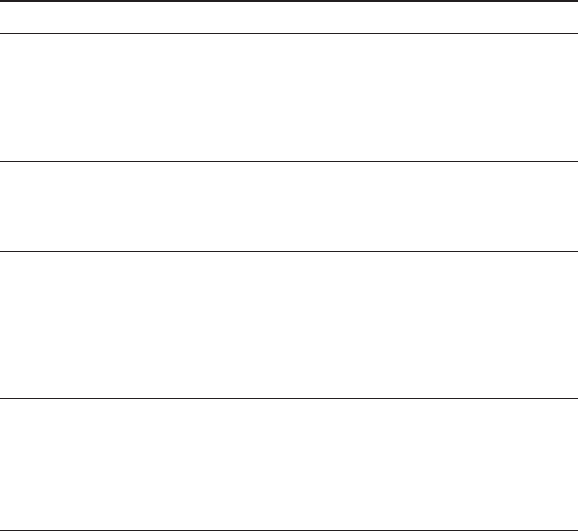
32
FR
Symptôme Cause/Remède
L’échange de fichier
avec un autre
ordinateur VAIO n’est
pas possible.
L’ordinateur équipé
d’un adaptateur USB
Bluetooth n’entre pas
en mode d’attente.
La communication
Bluetooth a échoué à
mi-chemin
Le message « Le
périphérique Bluetooth
doit être authentifié »
apparaît dans la zone
de notification.
cSi une version antérieure du logiciel BlueSpace est utilisée,
il peut y avoir des problèmes avec le service de transfert de
fichier. Vérifiez que les versions les plus récentes du
logiciel BlueSpace et du pilote d’appareil Bluetooth cible
sont utilisées. Pour les informations sur la mise à jour de la
version du logiciel, reportez-vous au site Internet vaio-link.
cLa commutation automatique en mode d’attente n’est pas
possible si l’ordinateur communique avec d’autres
appareils Bluetooth. Pour entrer en mode d’attente,
terminez toutes les communications Bluetooth.
cTerminez la communication BlueSpace et débranchez
l’adaptateur USB Bluetooth du connecteur USB, puis
rebranchez-le dans le connecteur et essayez de nouveau la
communication Bluetooth. D’autres appareils situés dans
l’entourage de la communication LAN sans fil peuvent
provoquer l’arrêt à mi-chemin de la communication
Bluetooth
cLe périphérique compatible Bluetooth cible a besoin d’une
authentification de la connexion. Une authentification
mutuelle est nécessaire pour permettre les communications
Bluetooth avec ce périphérique. Pour plus de détails,
reportez-vous à la section « Communications à l’aide des
fonctions Windows XP » (page 15).

Printed in Japan